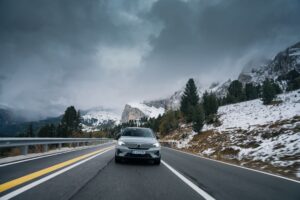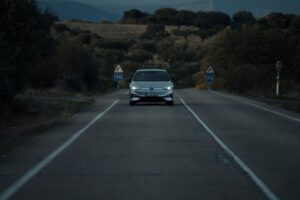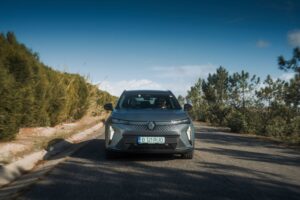The journey through Europe gave us the opportunity to discover how eight of the newest electric models available in Romania perform on a route totaling about 9,000 kilometers. At the same time, #EUROCHARGE was an opportunity to see how the charging station infrastructure is developing in European countries, and here we were in for several pleasant surprises.
After seeing in Salzburg how an urban station hub can integrate a business lounge suitable for relaxing or co-working under the MOONCITY brand, we continued our way to Romania on the highway to Vienna and stopped at the OMV station in the Laakirchen area.
And here we saw for the first time an excellent example of how new technologies can integrate harmoniously with existing technologies: the OMV Maxx Motion gasoline and diesel pumps are under the same roof as the OMV eMotion fast-charging stations. And they are by no means few, as there are six charging stations here with speeds of up to 300 kW and electricity from renewable sources.
Basically, for you as a driver, the user experience is similar no matter which car you drive. And this is, in fact, the main message: electric cars and internal combustion cars are not mutually exclusive, but exist in parallel, each with their good and not so good parts.
This concept of a station with fuel pumps for thermal cars positioned next to charging stations for electric cars will gradually be rolled out in many other places. And we saw it for ourselves on the very same day, as we continued our journey through Hungary after a pizza lunch at L’Osteria Parndorf next to the famous outlet outlet in the Austrian town of the same name. At the OMV station in Szigetszentmiklos we found the same concept, this time with two OMV eMotion charging stations next to the fuel pumps.
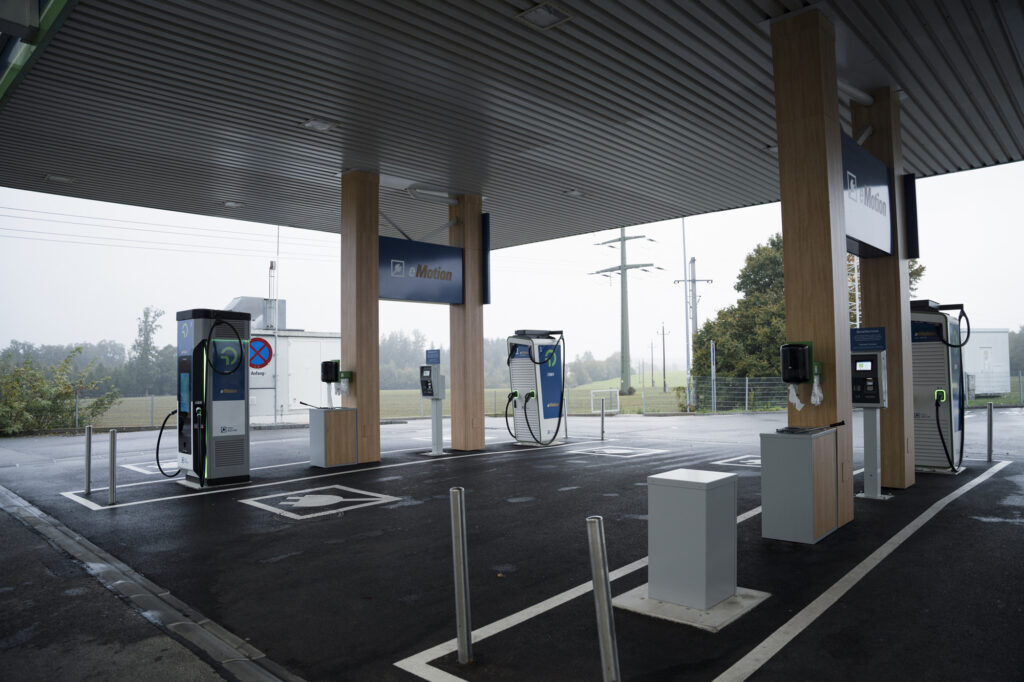
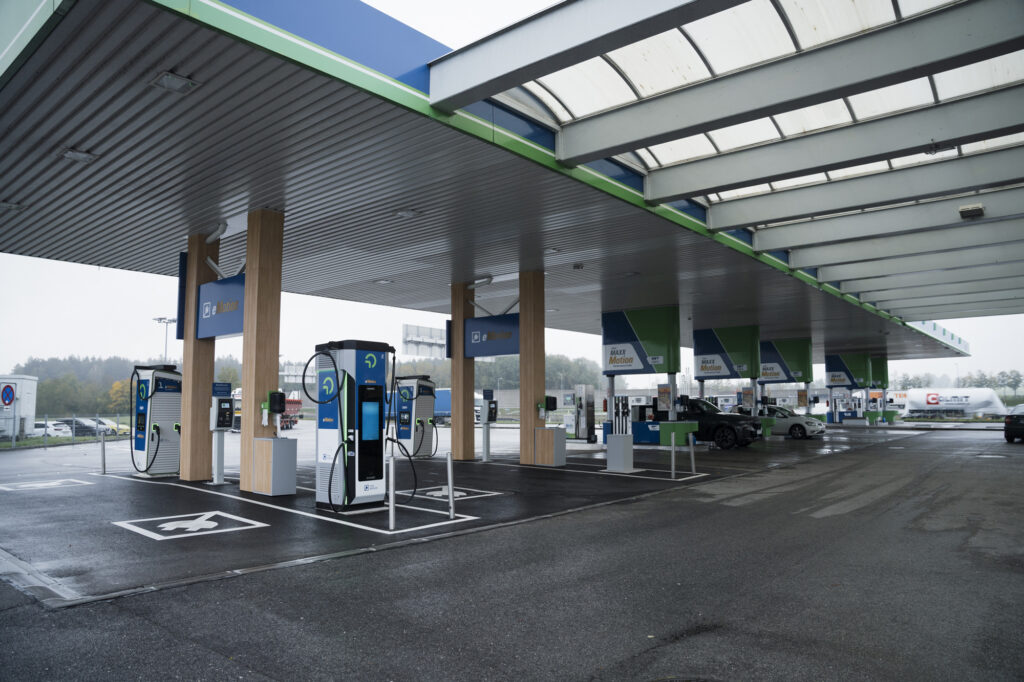
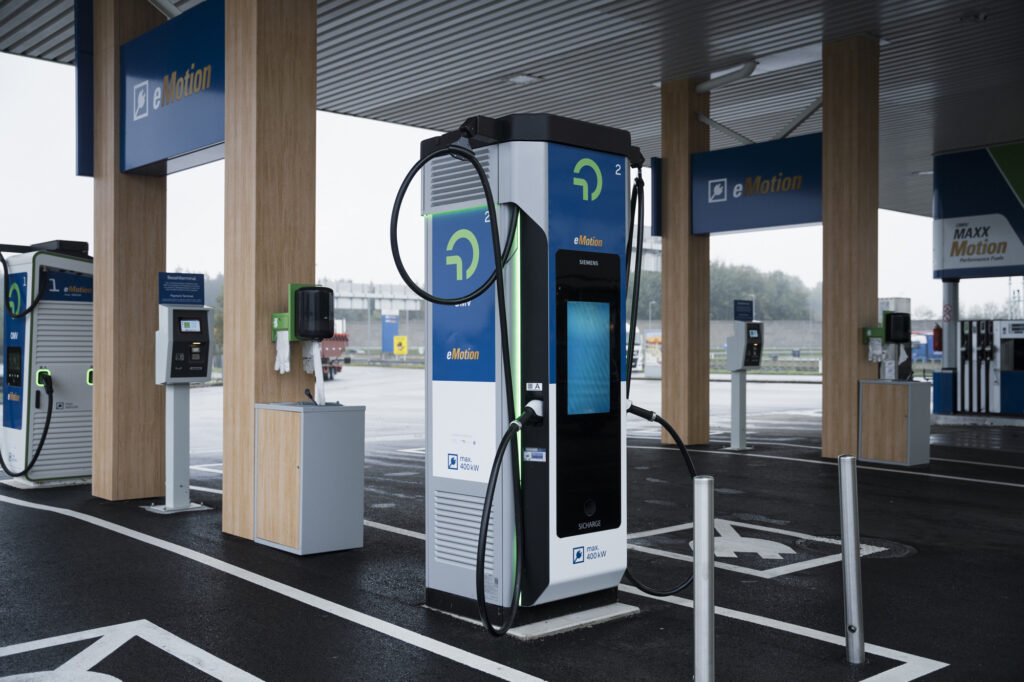

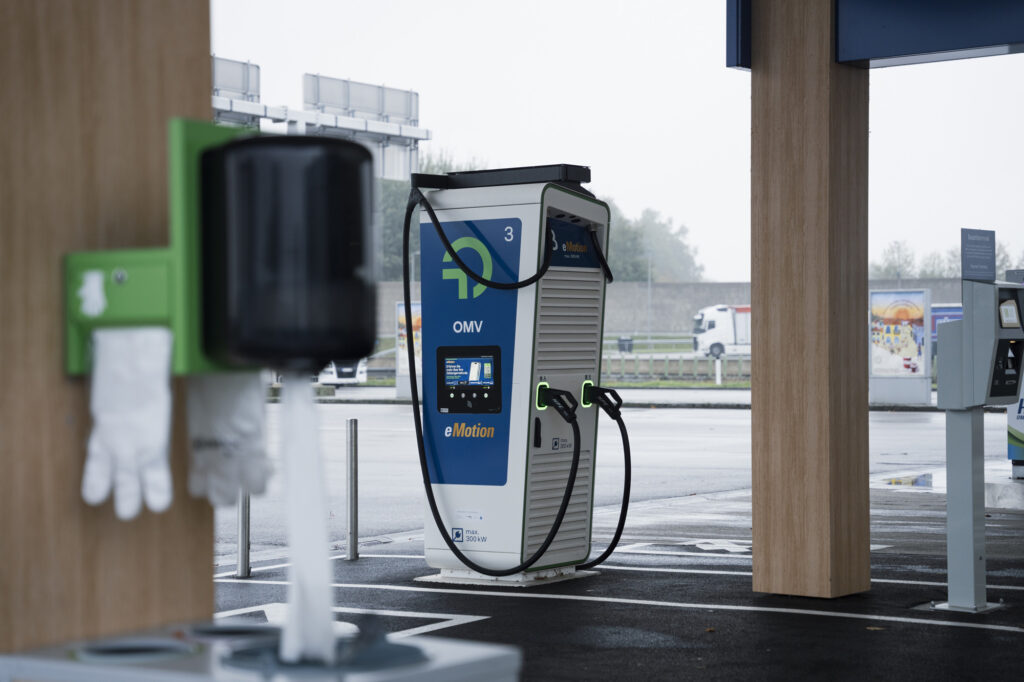

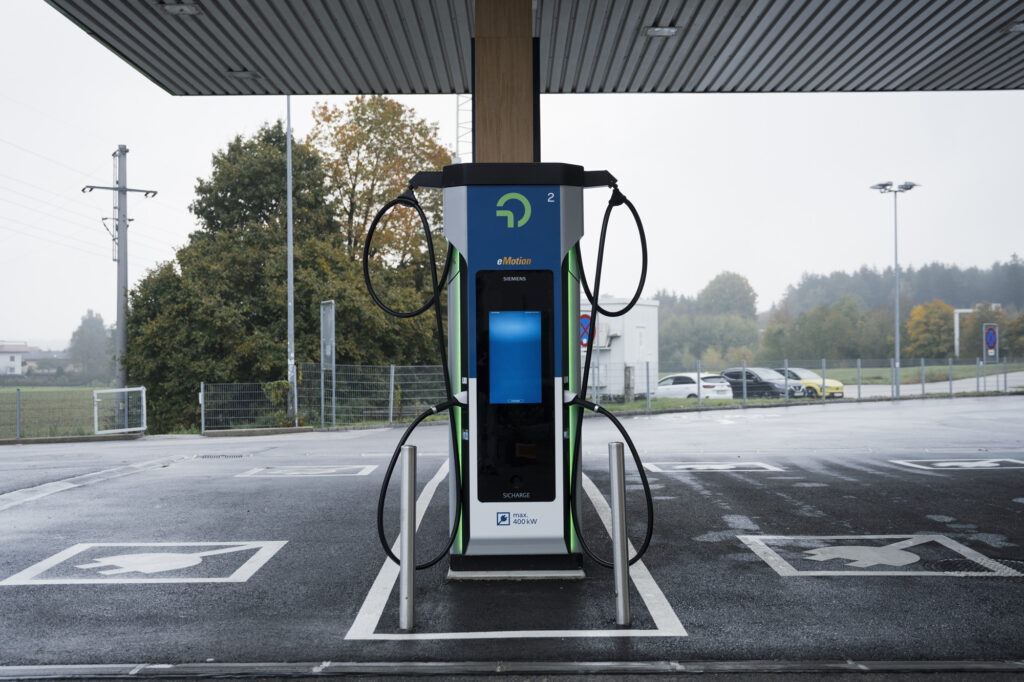
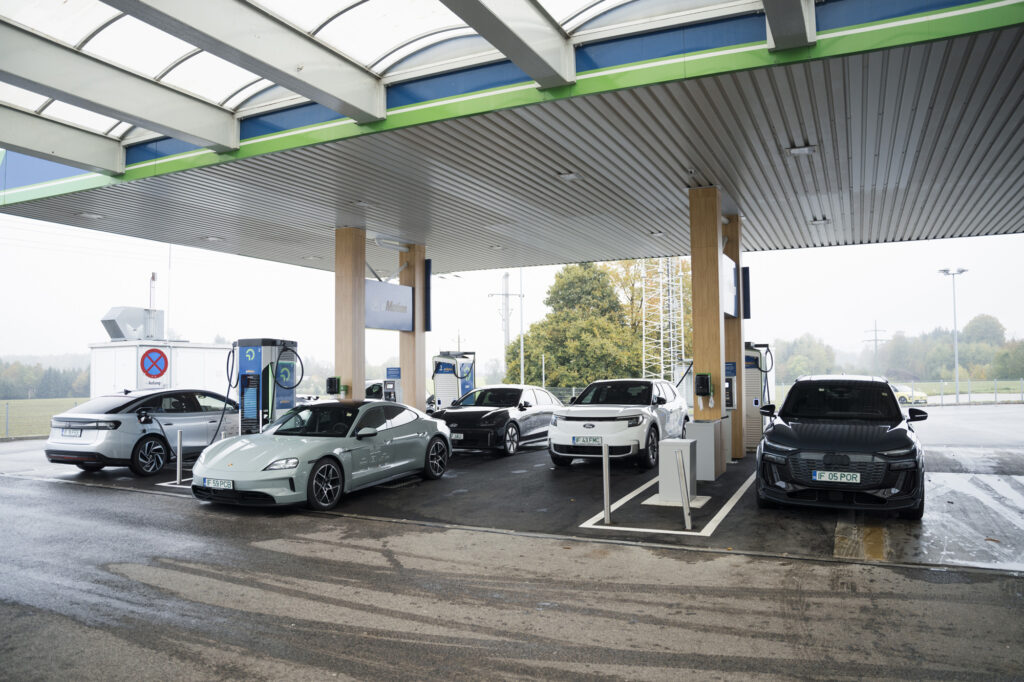
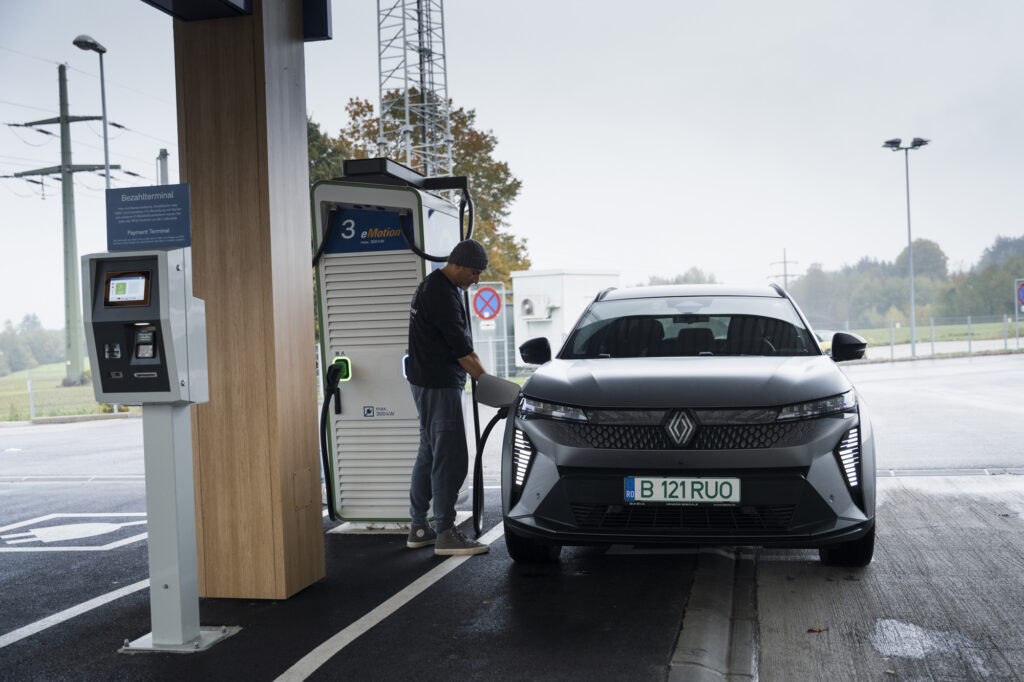
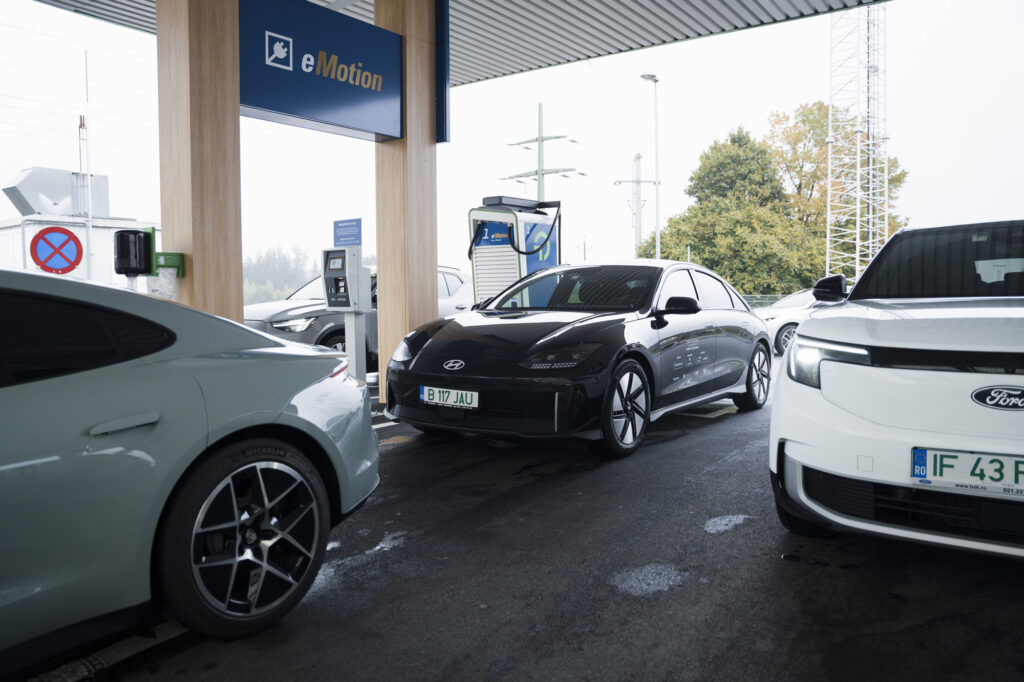
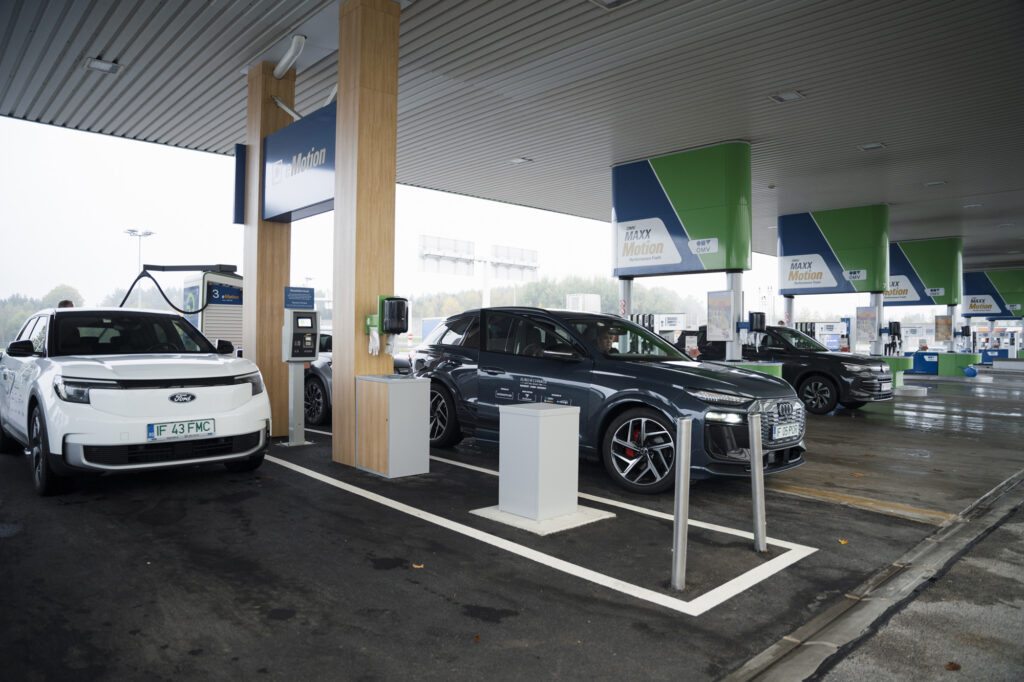
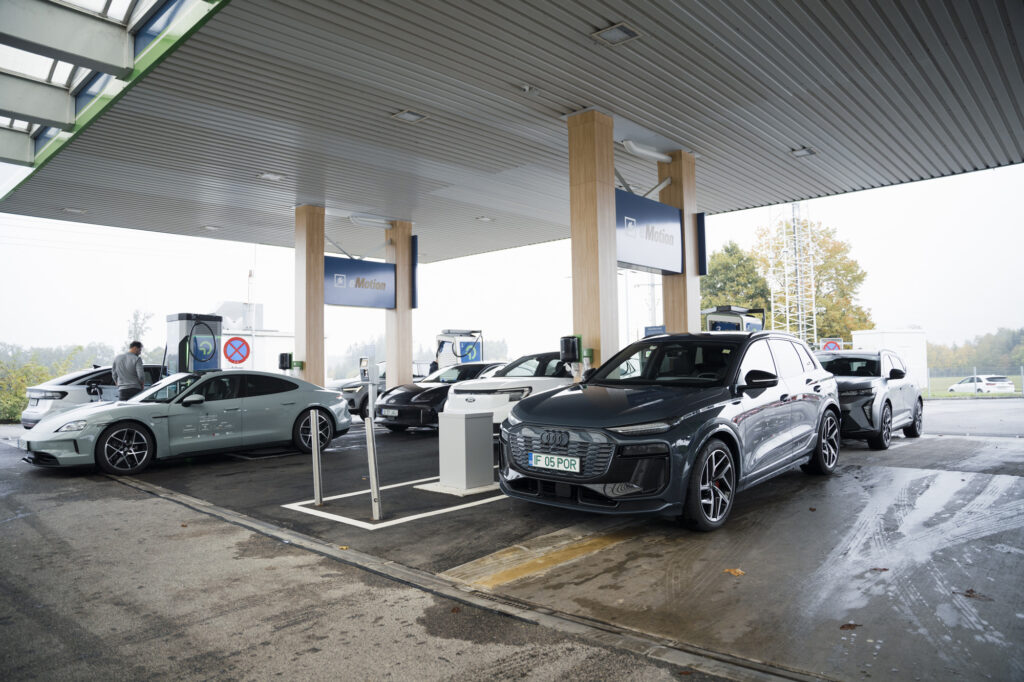
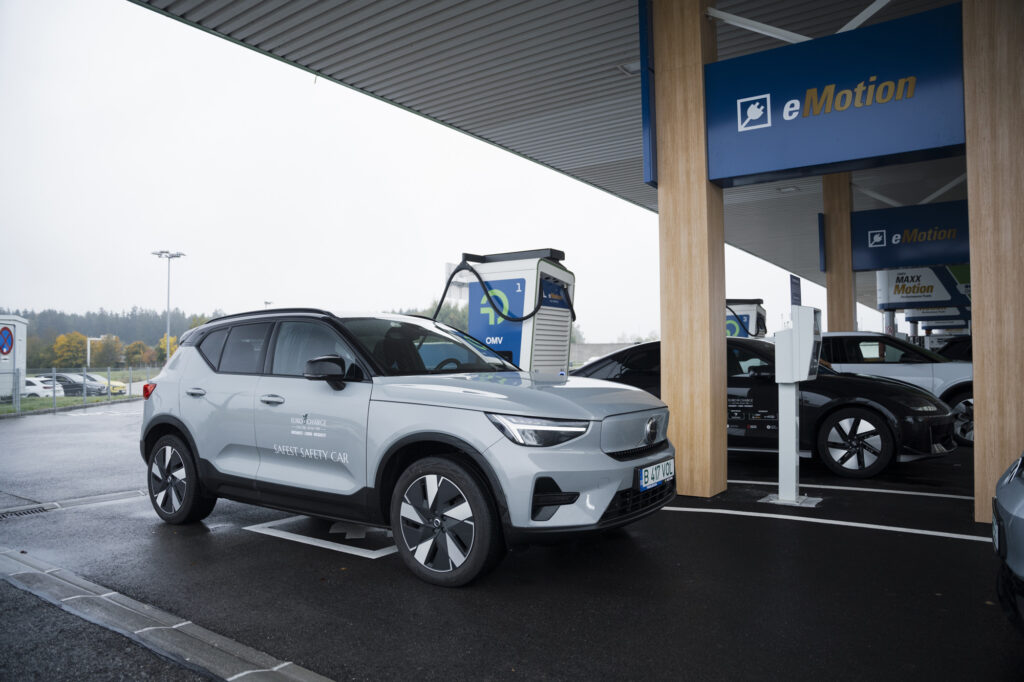
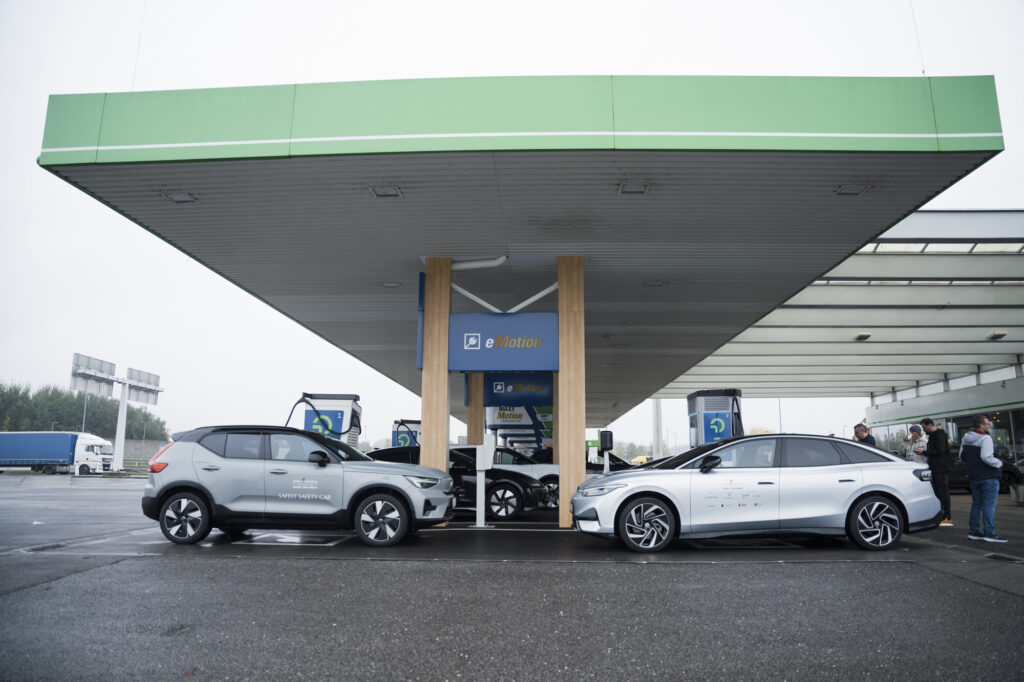
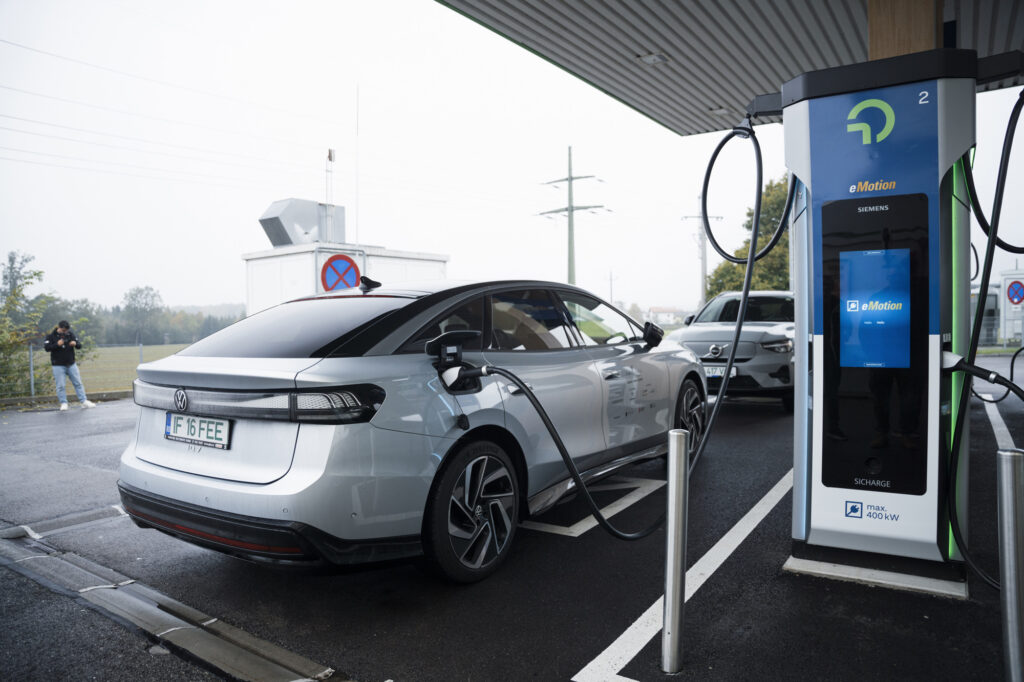
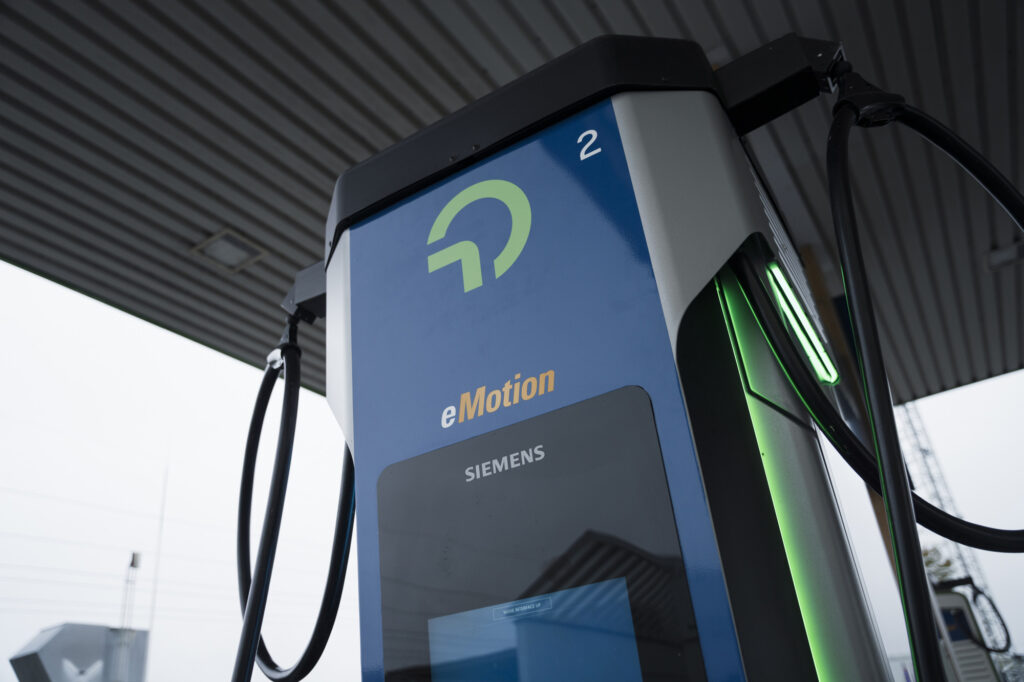
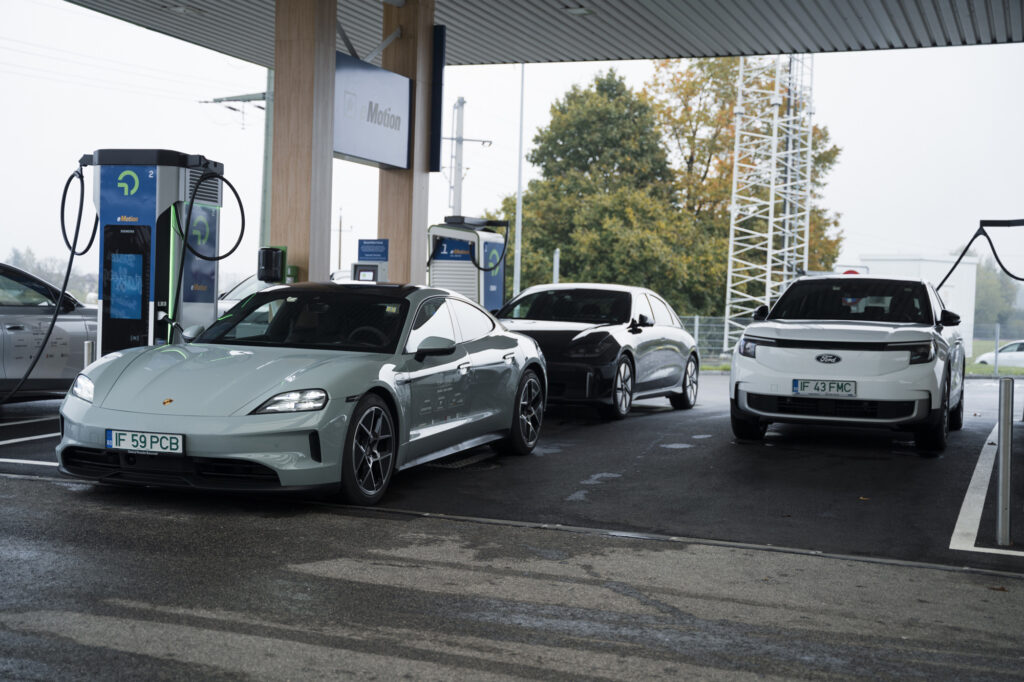
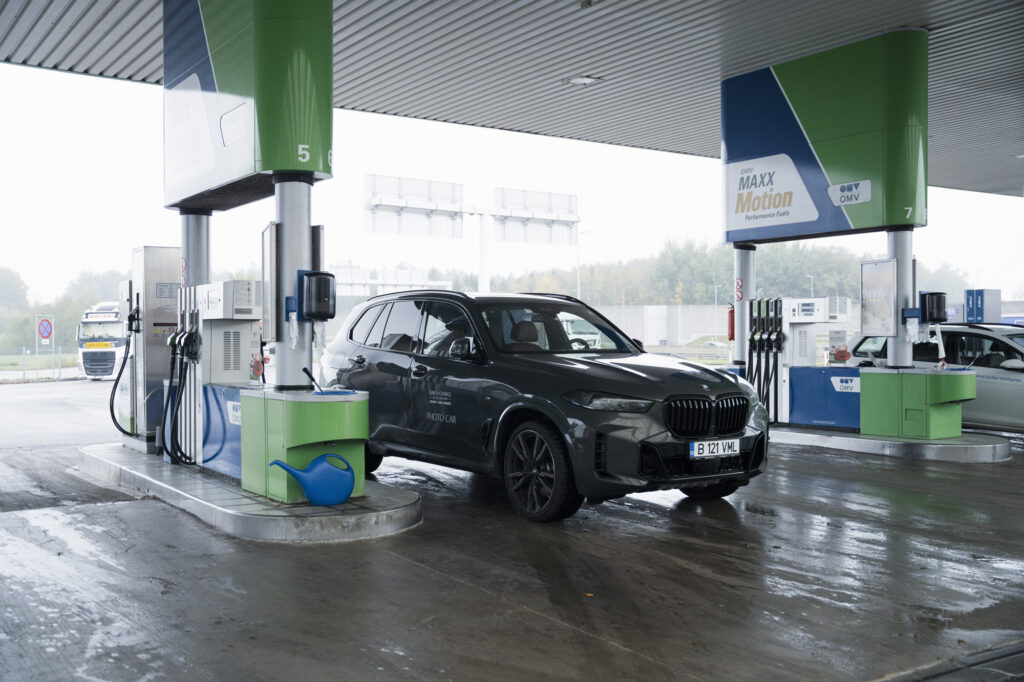
More time in customs than loading
Crossing Europe from west to east or vice versa is more of a formality thanks to the many highways, but things get complicated when it comes to Romania. While most colleagues chose to enter the country via Cenad, two of the eight crews waited exactly 60 minutes at the border crossing at Nădlac.
In other words, we waited longer at the entrance to the country than at any of the electric car charging stations during the 16 days of #EUROCHARGE.
The pleasant surprise was that in Nădlac we discovered two Petrom Electric fast-charging stations of up to 300 kW at the Petrom Electric station in the town, where we quickly charged the battery even though we had the possibility to do this overnight at the hotel.
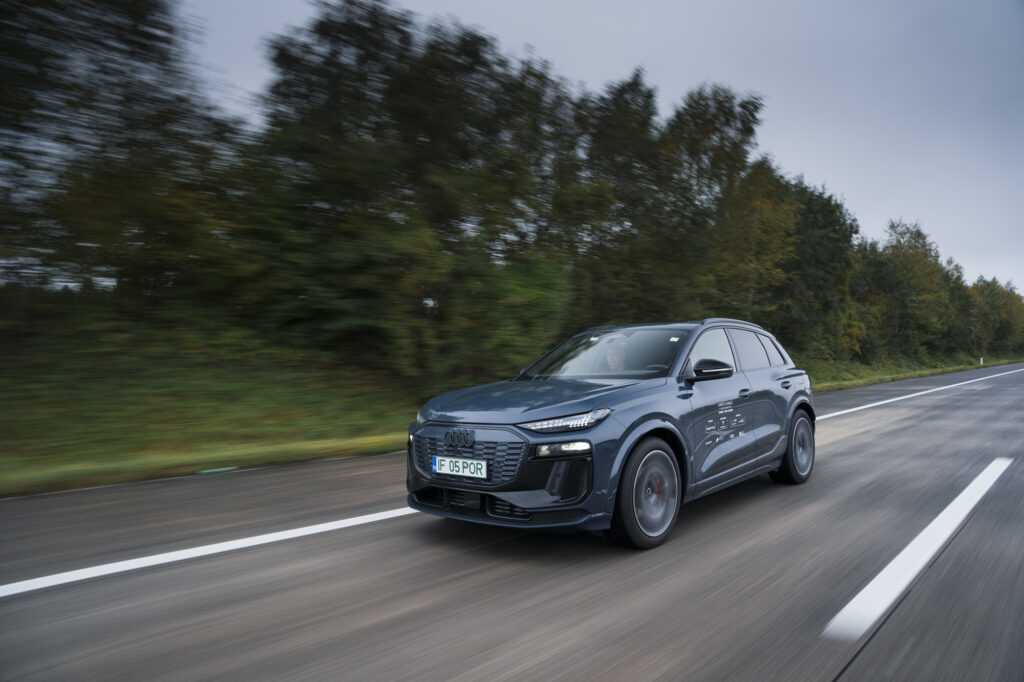
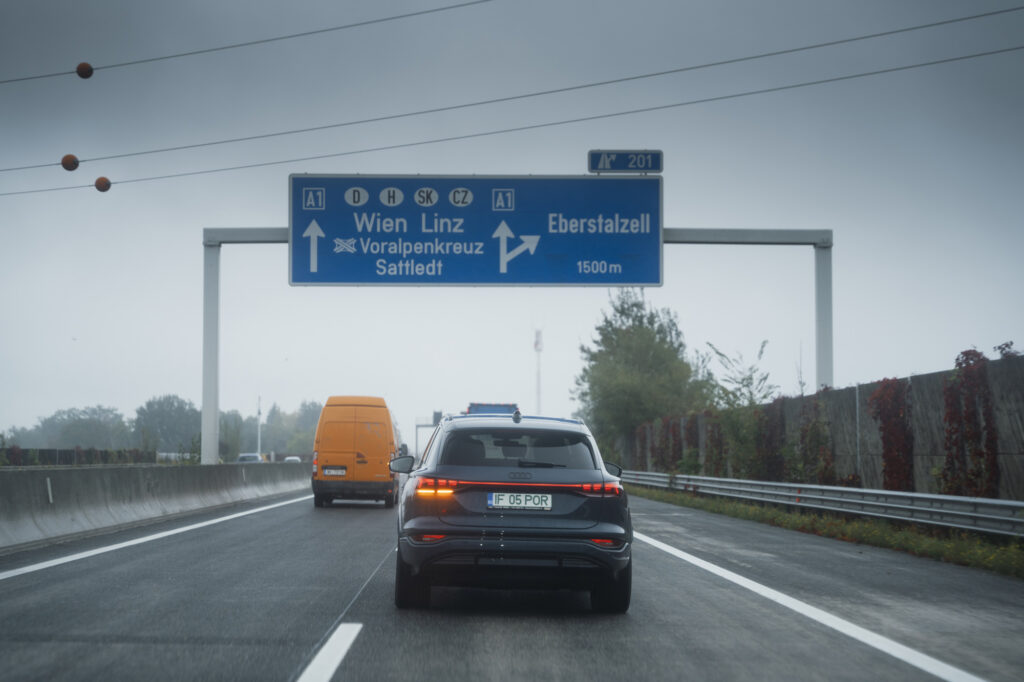
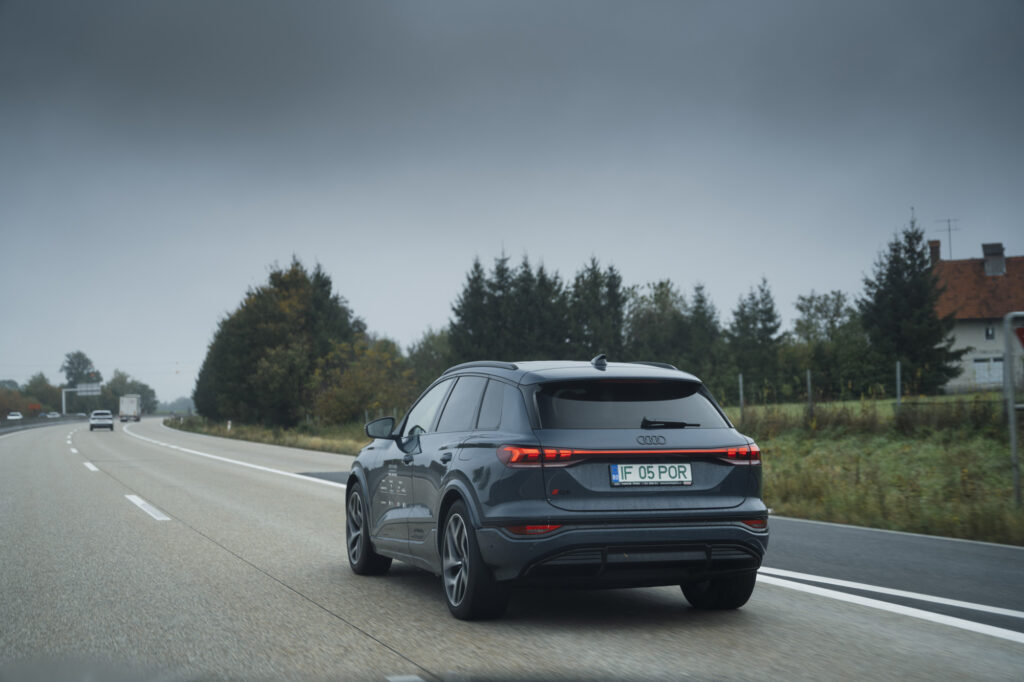
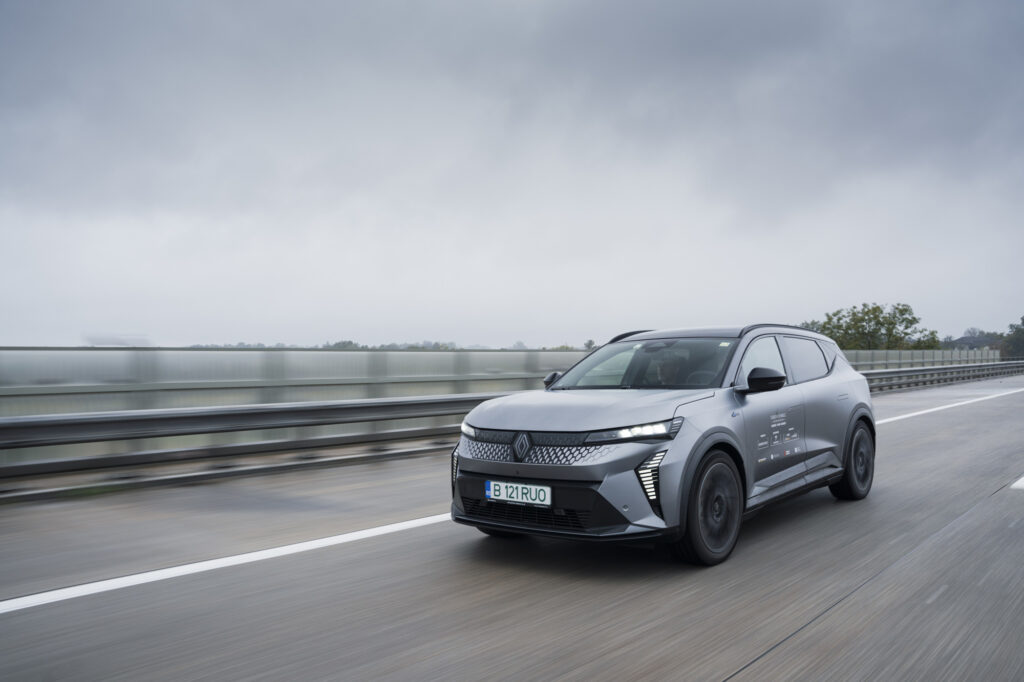
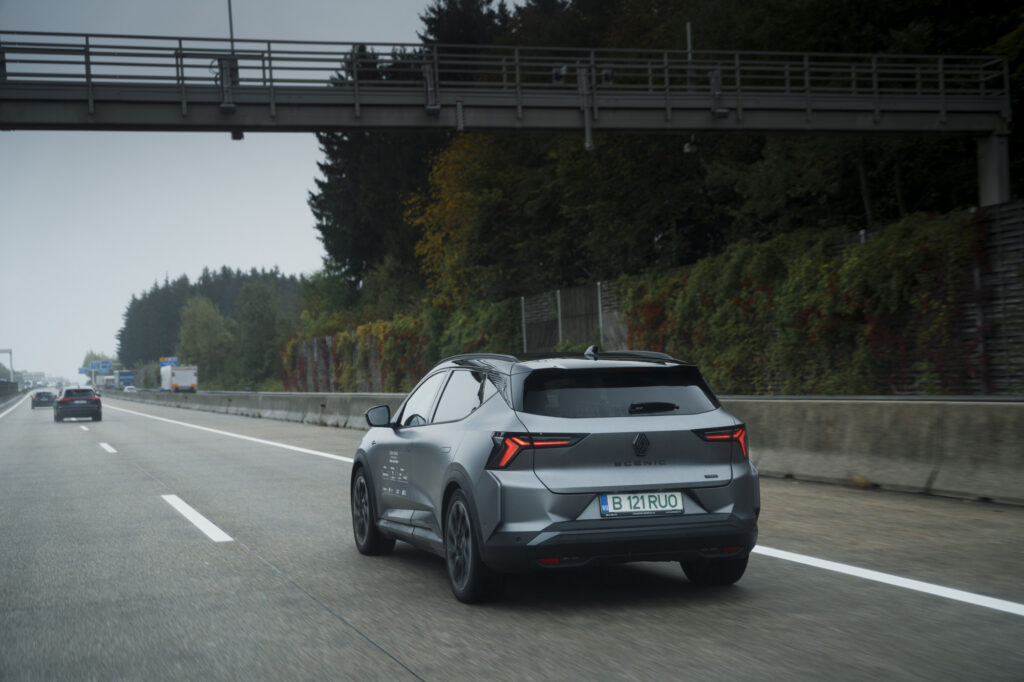
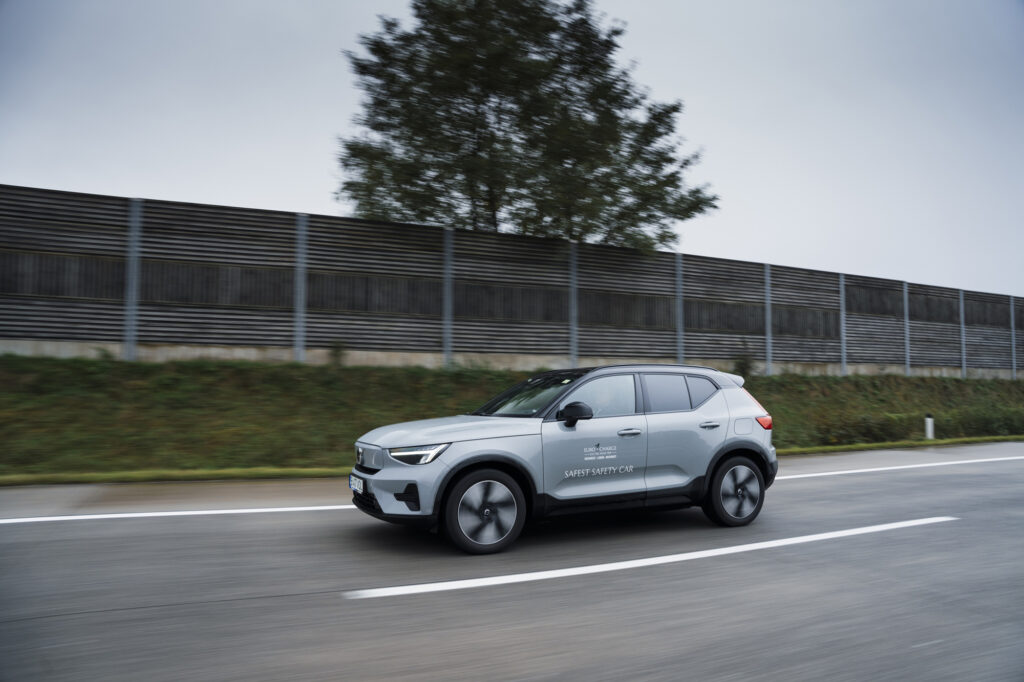

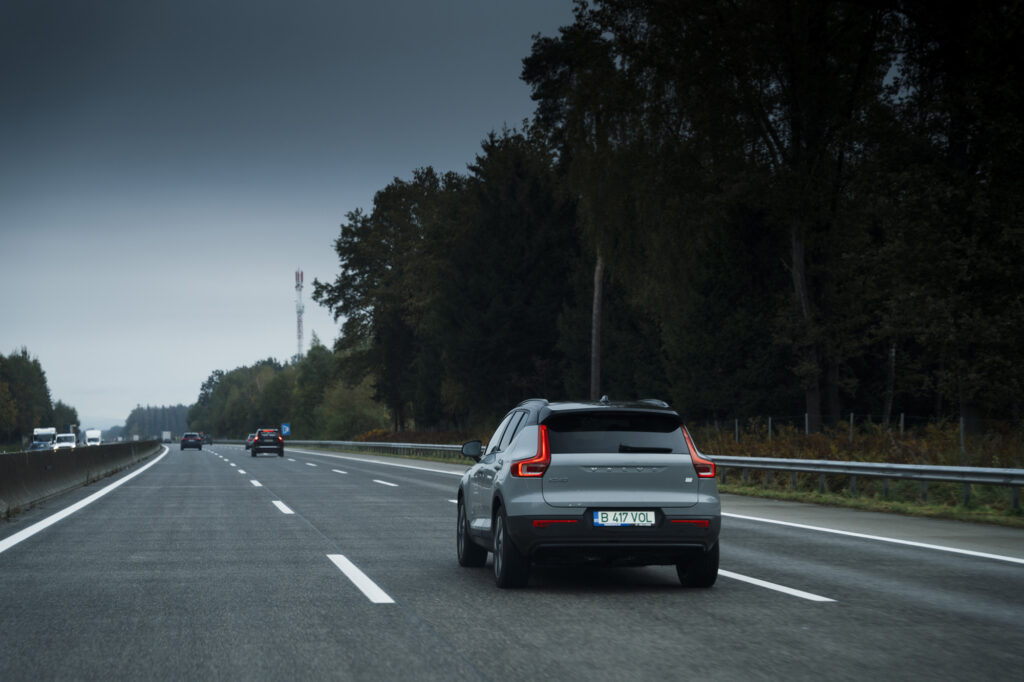
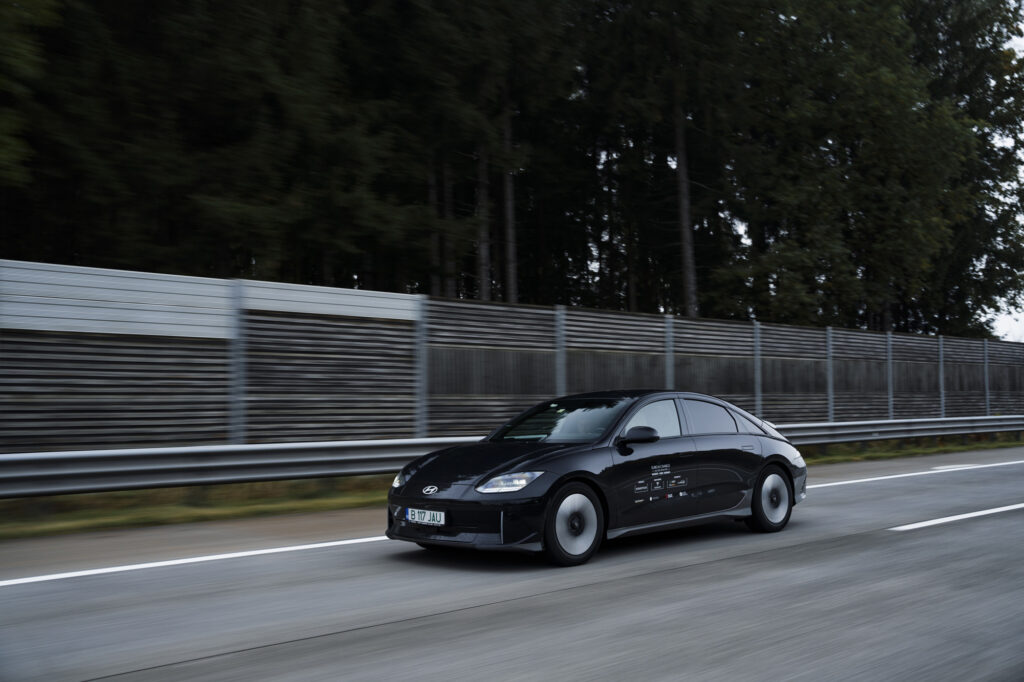


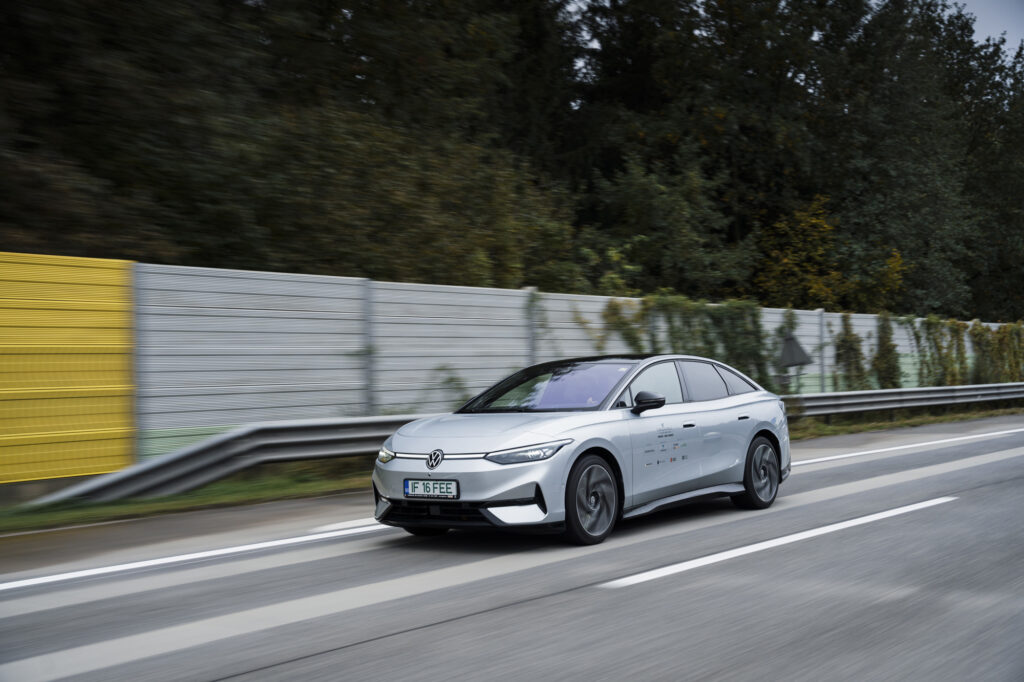
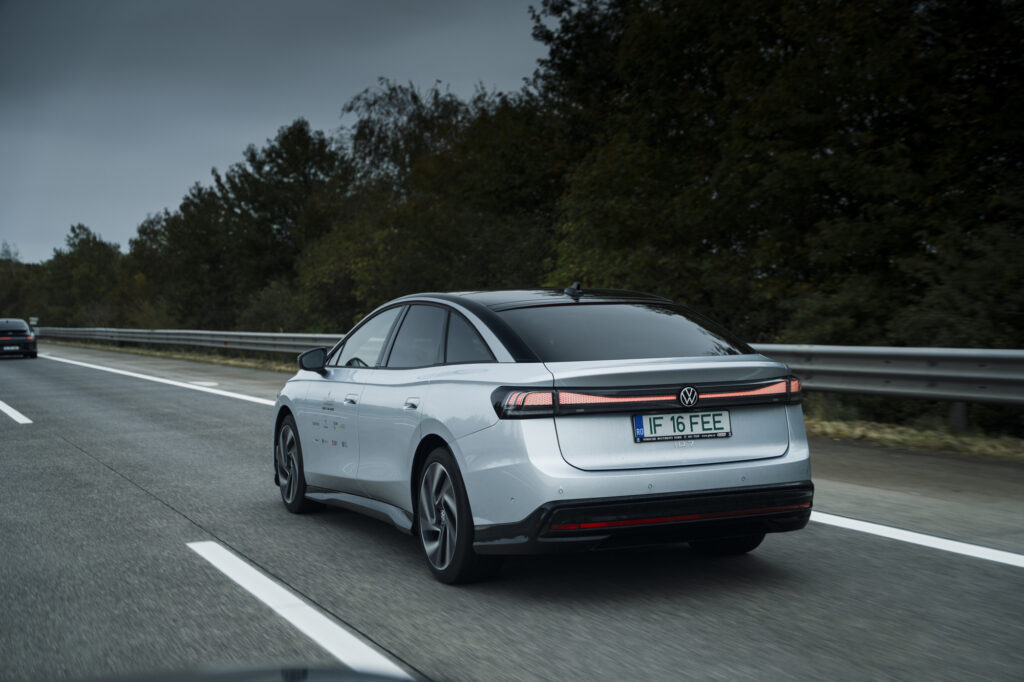
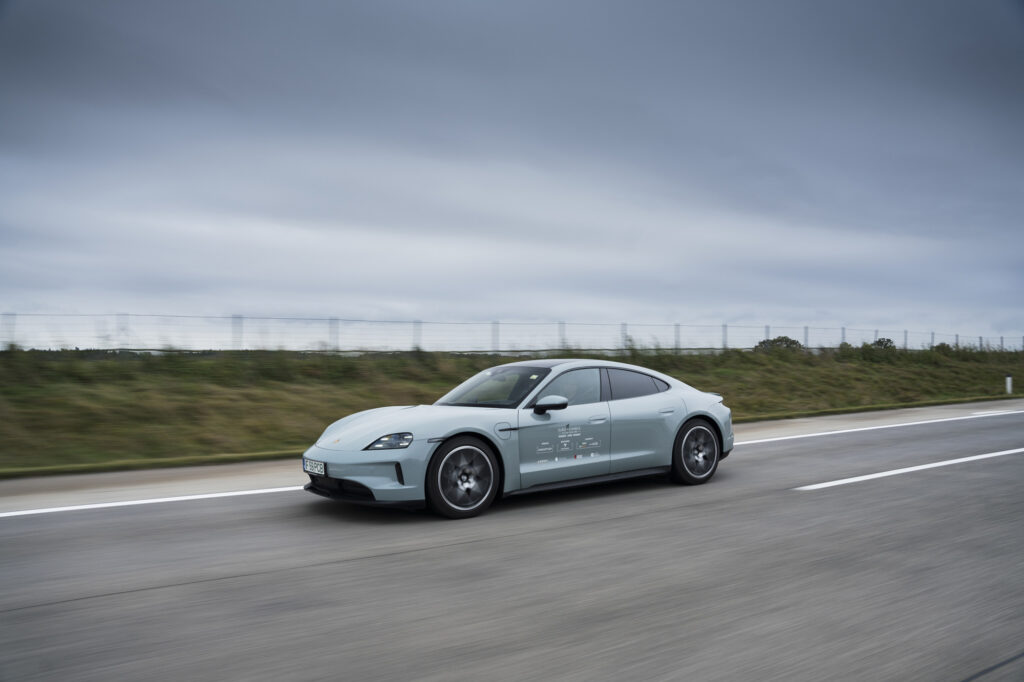
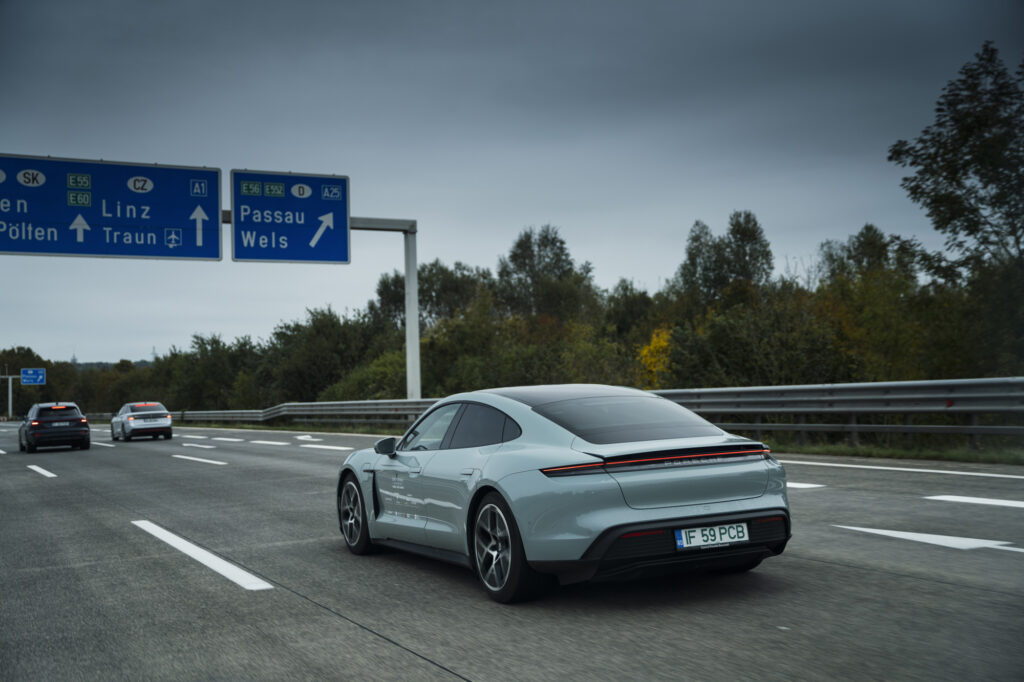
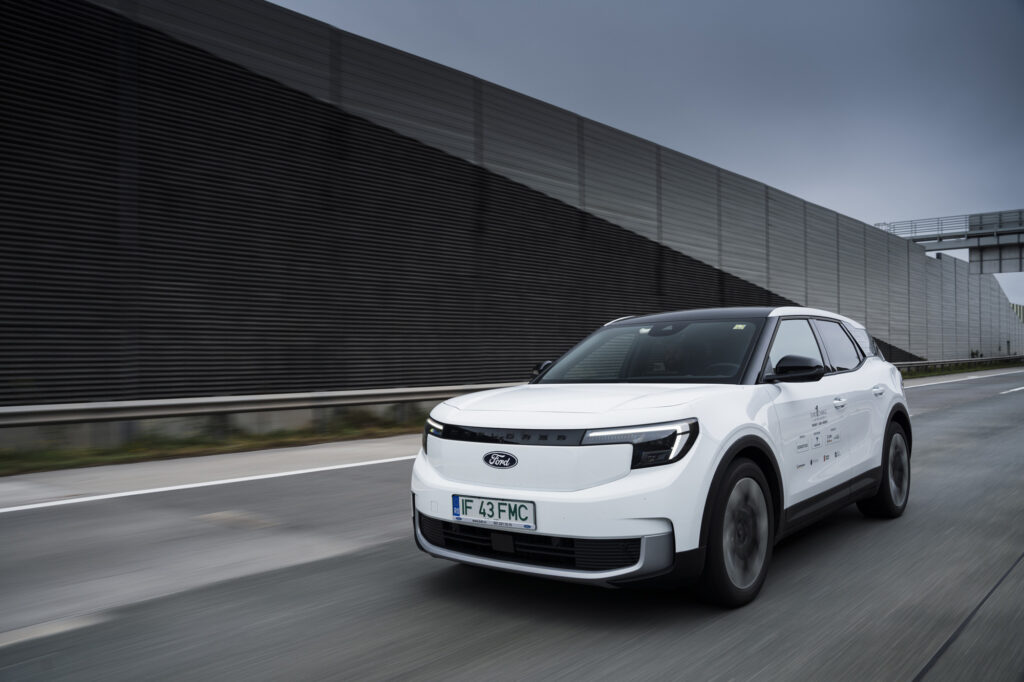
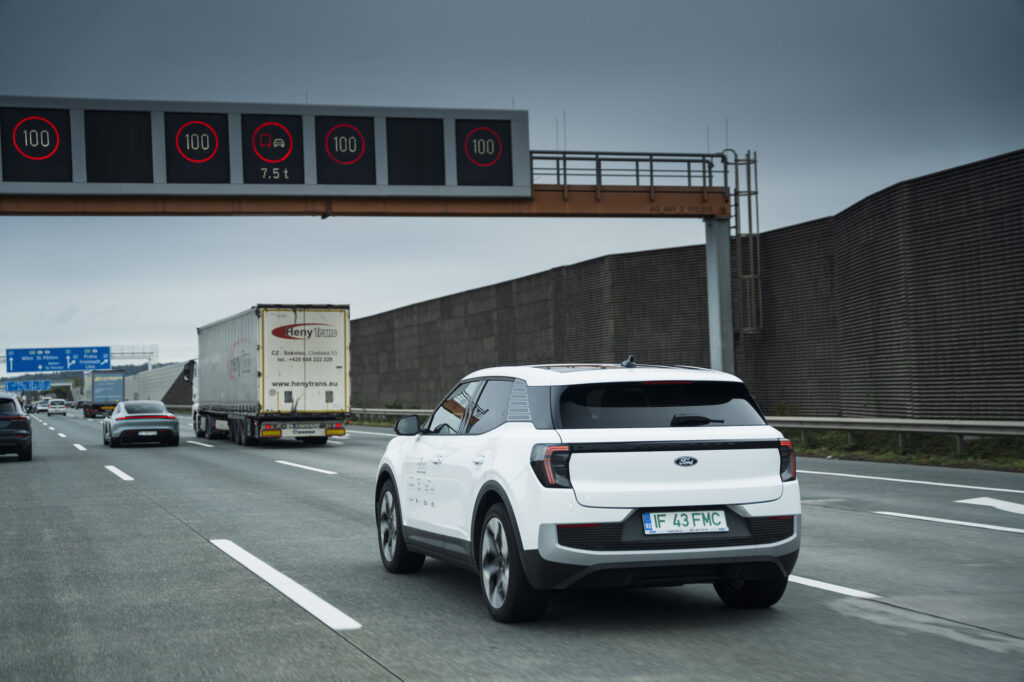

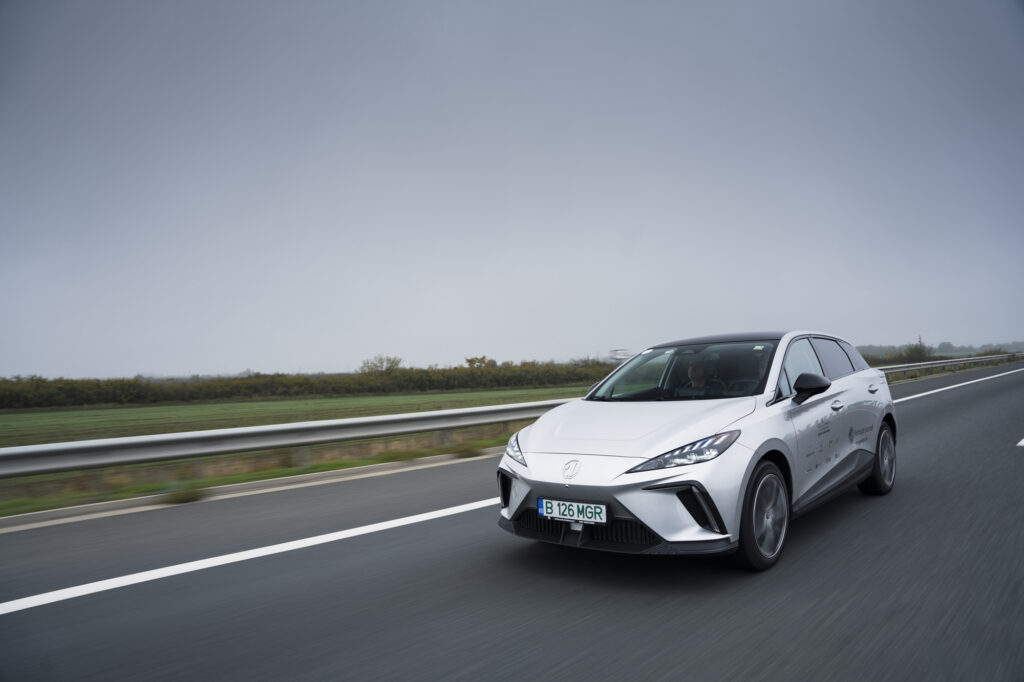

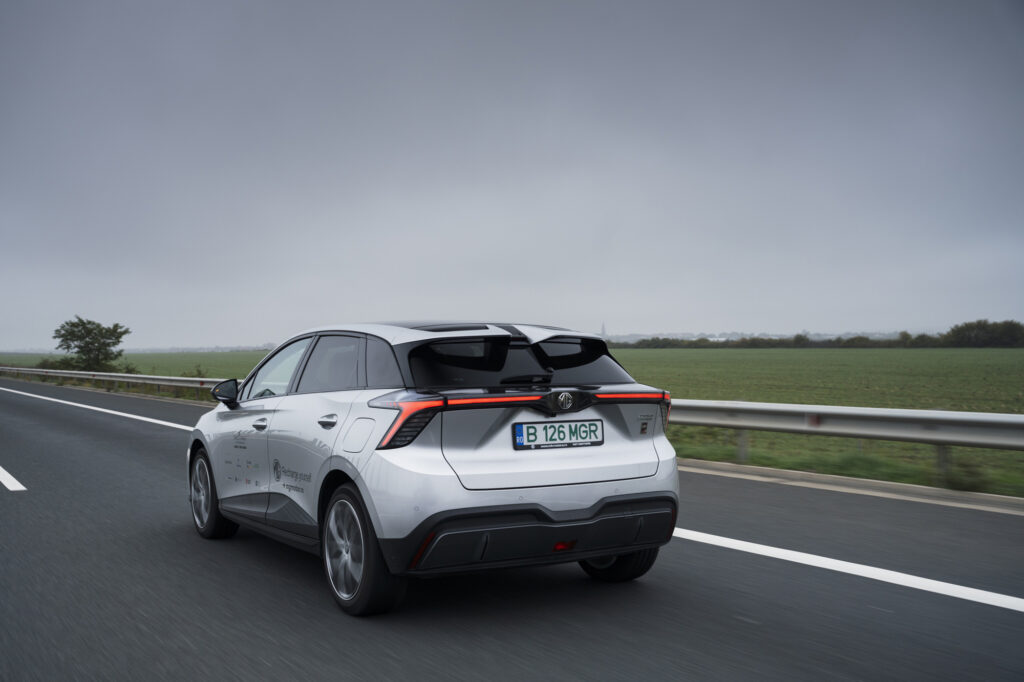
And, after a good night’s rest at the Mercure Timisoara, in the morning we set off for the Capital. The first stop of the day and the last organized stop of our tour was at OMV Margina, where we scheduled a last regrouping for all the journalists involved in this road trip. From here, it was off to Bucharest, but not before some of us took advantage of the fast stations of up to 300 kW to charge our batteries.
Later, after the smooth ride on the highway to Sibiu, some of us chose to go home via Brasov, while the brave ones who ventured on the Olt Valley lost more than an hour in traffic due to some roadworks.
No matter how we got to the country, after #EUROCHARGE we are left with memories to last a lifetime and the satisfaction of having taken part in the most spectacular adventure of our lives: 20 people traveled 16 days across Europe on the Bucharest – Lisbon – Bucharest route with eight electric cars.
We made it to the shores of the Atlantic Ocean, crossed the Dolomites and the Pyrenees and visited two museums in France with special significance for European car culture and beyond. Most of all, we proved that in 2024 you can travel in electric cars without any thrills, even when you do it for 16 days over some 9,000 kilometers.

In the coming period, on AUTOCRITICA you will find detailed reports for each EUROCHARGE electric car, with relevant data such as actual range, average fuel consumption, charging times or running costs, so that you can easily choose the right model for you if you are thinking of buying an electric car.
In the meantime, I invite you to read colleagues’ impressions of the cars they drove home.
Andrei Barbu(MotorVlog TV) on Audi Q6 e-tron
The Q6 e-tron is the last electric I’m driving on this tour. And that means I can “judge” it by the standards and lessons learned with the rest of the cars.
The drive from Salzburg to Timisoara is neither very long nor very demanding, but it’s still almost 900 kilometers. That’s enough time to realize that the Audi Q6 e-tron is a superbly built car. Materials, details, buttons, controls, ambient lighting, everything is faultless. As it should be if you take a look at the price list. Said another way, the Q6 e-tron is a pure-blooded Audi, premium without a doubt, with technology and skills to match.
The air suspension is the link that severs any connection between the imperfect asphalt and the interior, the sound deadening gives you no audible clue as to how fast you’re going on the highway, and the gorgeous seats are the perfect companion for a long drive. As for efficiency, there’s a lot to say here. But I’ll make just one point: the Q6 e-tron charged from 12 to 70% in 17 minutes, with an average charge rate of 198 kW. Absolutely MI-NU-NAT!
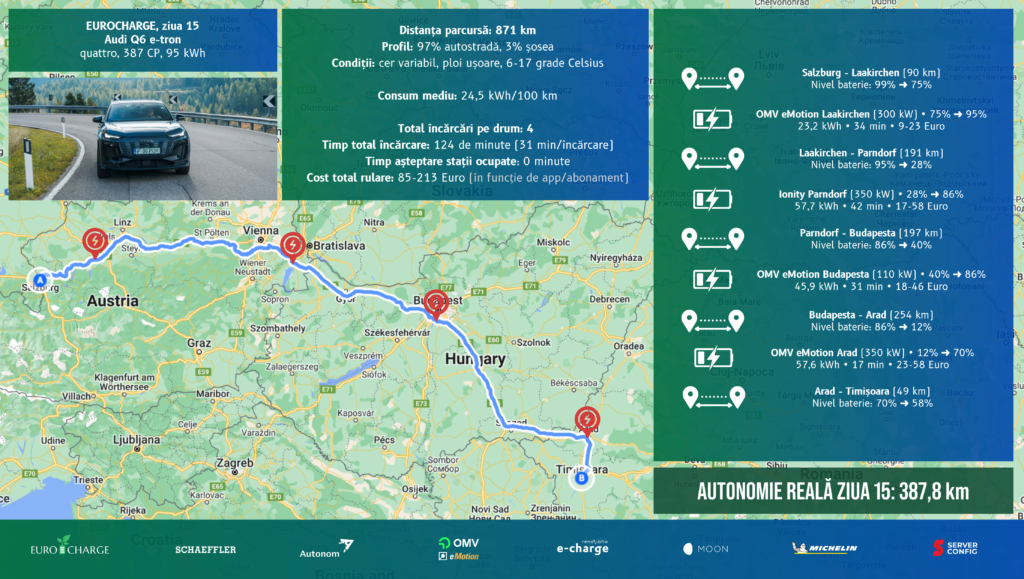
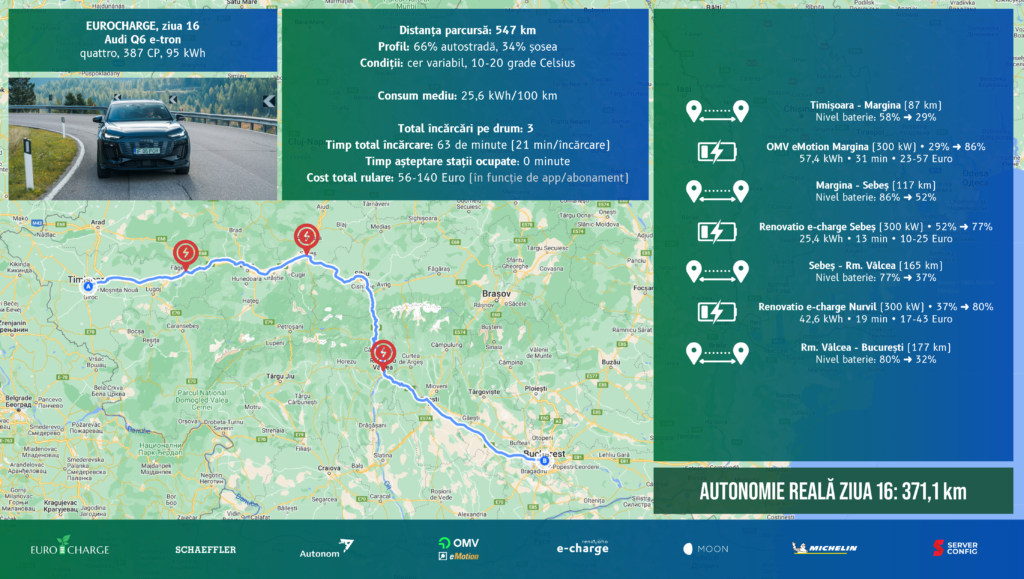
Tiberiu Buzdugan(electromobilitate.com) on Ford Explorer EV
I think it’s impossible to look at the Explorer without thinking of American cars. It’s squarish, but somehow modern at the same time. Personally, I like it much more than the car with which it shares the platform, the Volkswagen ID.4.
Inside, it’s very roomy, with materials that don’t necessarily feel premium, but they don’t necessarily feel plasticy either; they certainly feel durable, befitting the car’s more rugged design. I found the vertically arranged center screen easier to use when it comes to navigation via CarPlay, with more useful maps visible at all times.
Being a platform sibling to the ID.4, unfortunately it has also taken over many shortcomings from Volkswagen, the lack of physical buttons being the biggest of them. The adaptive cruise control works very smoothly, with automatic gear changes based on road signs. But setting it from the touch buttons on the steering wheel is horrible, the most clunky and imprecise of anything I’ve driven so far. In terms of soundproofing, it’s like they didn’t get the ID.4’s right, with the Explorer noticeably louder at speeds over 60mph.
What impressed me most was the long-distance efficiency. Despite the “fridge on wheels” aerodynamics, the car manages to get very good highway fuel economy. And even though the maximum load rating is “only 135 kW”, the load curve is quite flat and it doesn’t take very long before the car is ready to go.
Radu Tudoroiu(Digital storyteller) on Ford Explorer EV
If you’re still driving a car 5-7-10 years, you have to like it and check all the boxes that are important to you, and the Explorer, in terms of shape and comfort, I think it’s where it needs to be. I don’t know if I don’t necessarily have the emotional training to debate all the technical aspects that make the Ford a good choice or it’s just a “I like it because it’s an emotional choice” situation, but I think the size, range and equipment that the model we tested meets many of the requirements.
Where it wins big, for me personally, is the 193 mm ground clearance. If I’m not mistaken, it’s either within legality, or a tad taller than the Q6 e-tron, making it the tallest car on the tour, where I also feel a bit more at home and don’t panic at the thought of a kerb or bumper fatally kicking out the front bumper, trim or stuff under the car. Okay, I know it’s not that common of a problem, but mentally it’s something I contemplate in parking lots.
All in all, the Ford Explorer is a great compact SUV that I quickly befriended. It seems like the kind of car ready for adventure, skiing, fishing or vacations, with a reasonable range and a pretty jovial handling, so to speak.

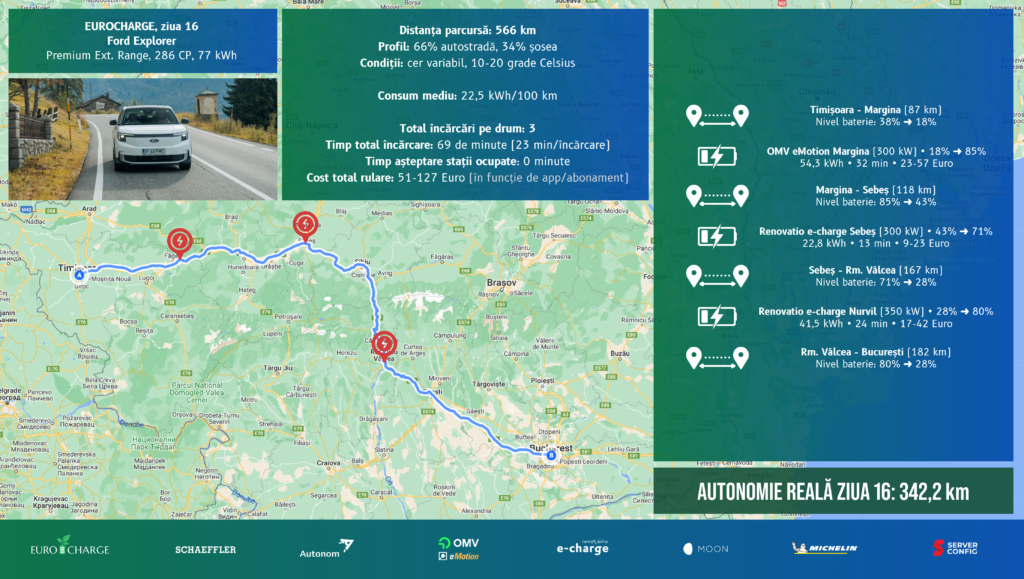
Laura Antonov(LaChicBoutique) about Hyundai Ioniq 6
At the end of the lineup in EUROCHARGE, I realized that I had two favorites at opposite poles – on the one hand, the most expensive car of the tour, the Taycan, for which I still dream of winning the Lotto, and on the other hand, the Ioniq 6, one of the most affordable cars of the tour.
So down to earth, the Ioniq 6 is the electric car I would buy and recommend to anyone.
Hyundai Ioniq 6 is the last car I drove on the tour, a model that instantly caught my attention. It has a distinctive design that you either fall in love with at first sight or you crinkle your nose and wonder what the author meant.
If you like it and think it has a sporty and stylish design, we think so too. If you think it’s oddly shaped, perhaps you should consider that this aerodynamic design contributes to low energy consumption and therefore a ‘dream’ range. And not only that, the Ioniq 6 actually floats, smooth and precise.
All the figures about the Ioniq 6, from price to range, make you smile, whether you like the design or not. For example, the 800-volt battery architecture makes charging times shorter than I needed to get back on the road after each charging stop.

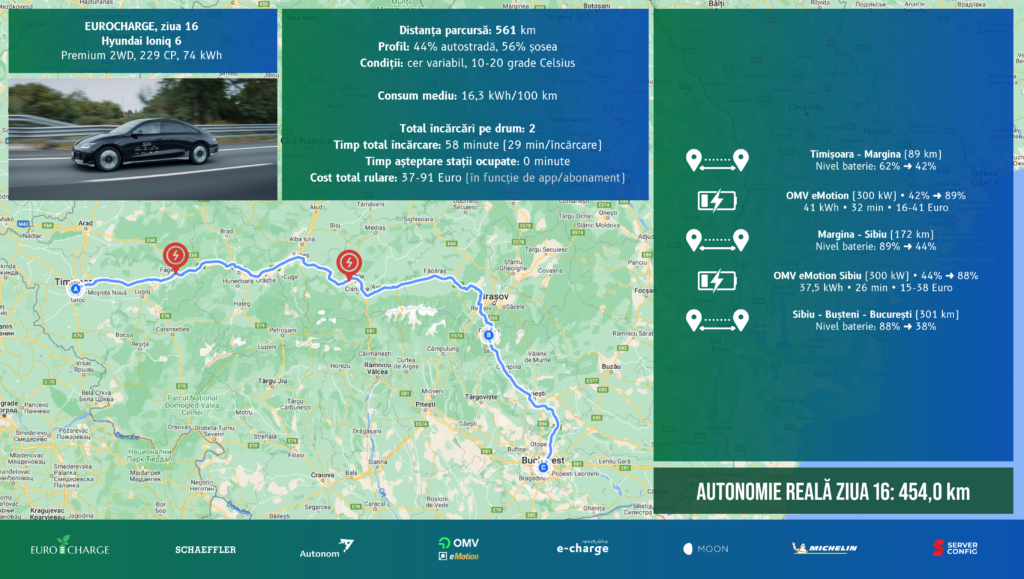
Adrian Mitrea(0-100.ro) on MG4
The MG4 pleasantly surprised me every time in EUROCHARGE by Schaeffler. Just the things that interest people are just right: the range indicated on the dashboard is precise and manageable, and the charging time reasonable. Around 30 minutes for 10-80%, enough to cover about 300 km. It’s also surprisingly comfortable and roomy.
A few elements, however, are worth MG’s overhaul. One of them is the ‘sticky’ suspension, which transmits fine vibrations into the cabin, especially at high speeds. The screens in the car are too bright at night, and the USB Type A-only cell-phone connection feels last-century.
All in all it’s a reasonable car. Sort of like an Opel, but from China, with the logo of a British brand rescued from the Far East.
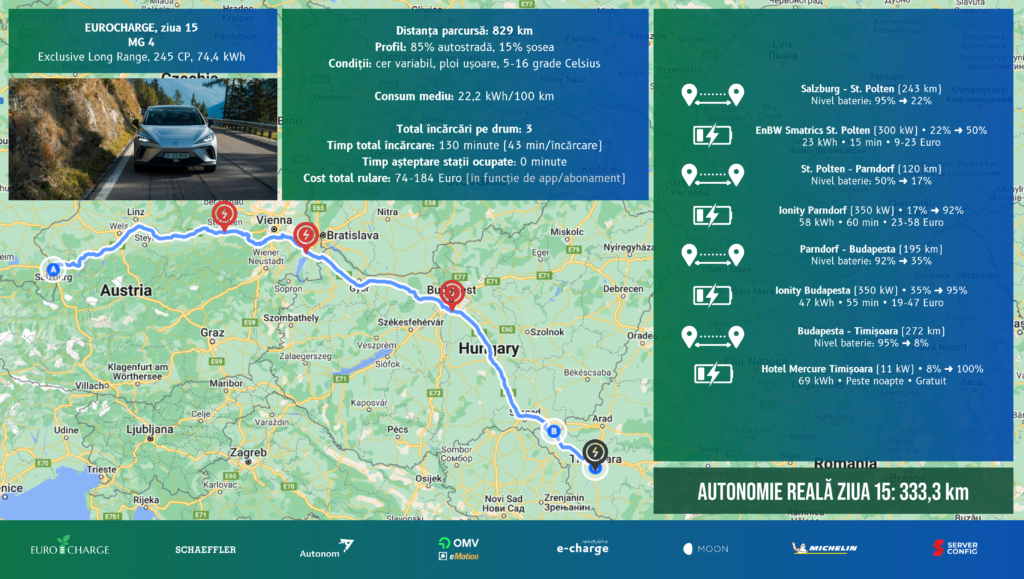
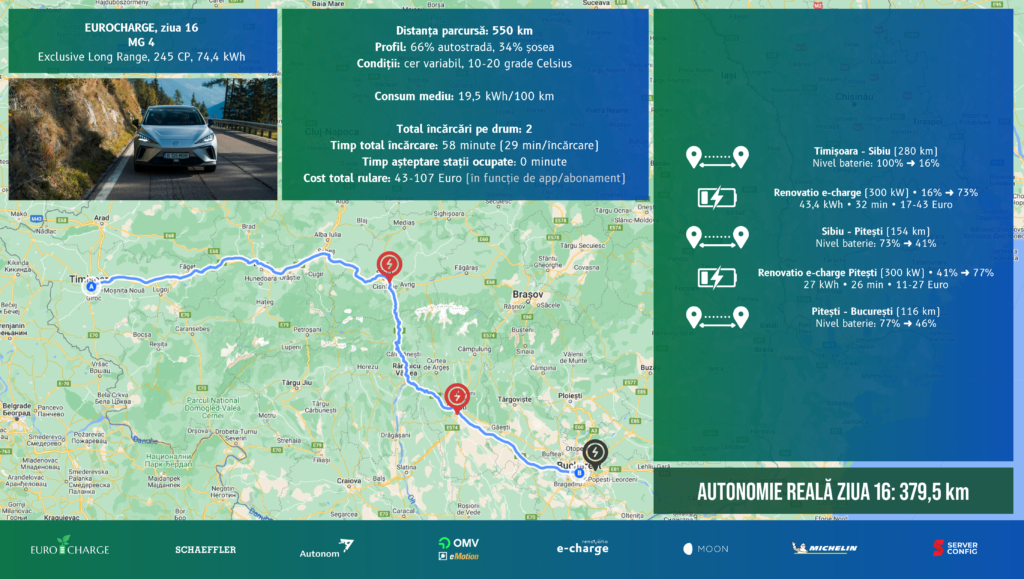
Mihai Vasilescu(Digital storyteller) on the Porsche Taycan
In theory, EUROCHARGE is not a test drive comparing electric cars. In theory, because in reality, the human mind doesn’t work like that. Or at least my mind doesn’t work that way, and I can’t help but notice, especially now that it’s my turn to drive it last, that there’s Porsche and…. the others.
It’s visible from everywhere you look, from anywhere, including the stratosphere, that the Porsche Taycan is the best-looking and best-performing car on this tour. And when I say “best”, I also mean that it has the longest range of any car we’ve tested.
I’m talking about real numbers, numbers that we’ve achieved here on the tour, where the car has been put through its paces on every possible terrain and on every possible road. From national roads to highways, from slopes to ramps, it’s been driven in all kinds of conditions, and the last three days have been exclusively on the highways, which is where the electrics have the hardest time.
Nothing, absolutely nothing prevented the Porsche Taycan from getting over 450 kilometers of range. I’ll give you the most representative examples, i.e. the range on the days when I did the most highway driving, namely from Valladolid to Dijon and from Dijon to Salzburg.
In the first, after 1,293 kilometers, it had a real range of 482.60 kilometers and in the second, after 873 kilometers, it had a real range of 453.30 kilometers.
Real autonomy, right? That’s exactly what it’s like on the ground, when I hope you can imagine that none of us have ever driven in the car in the car-load lane. When you’re behind the wheel of a Taycan, you can’t drive a Taycan in the drink-driving lane unless there’s a man in the back seat holding a gun to the back of your head.
When we weren’t just driving on highways, the Taycan had no problem getting up to 557 kilometers of real-world range.
In addition, the car knows how to draw a lot of current and very quickly, from the high-power stations, it even draws almost 300 kW. That means you never spend more than 15-20 minutes charging it from 10% to 80%.
Add to that 435 horsepower and 420 Nm of torque. That means you’re always behind the wheel of an adrenaline generator. What more could be said? Absolutely nothing.

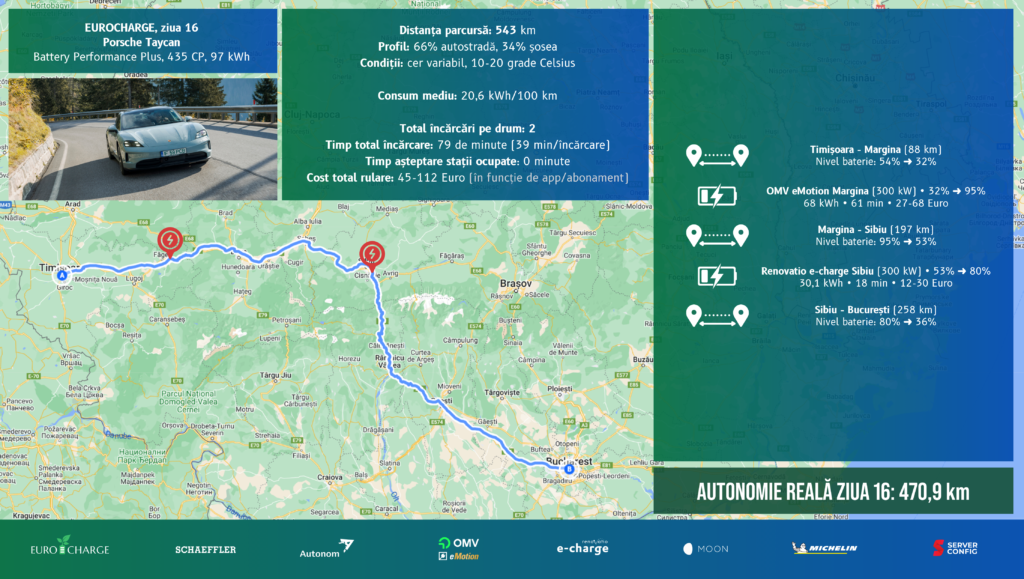
Constantin Ciobanu (AUTOCRITICA / Adevărul Auto) on Renault Scenic
Although people call it an SUV, I refuse to do so, at best I can accept the crossover classification. And because the interior is airy and bright, the minivan scent I still get it. But all of this doesn’t have much to affect the Scenic as a car and what it has to offer.
I’ll start with the trunk, because that’s where I got a surprise yesterday when I took the Scenic E-Tech on the road to the country. It has 440 liters, and had already adopted a trolley and a box, but its design also allowed the adoption of 2 more trolleys and some trinkets. Frankly, I was pleasantly impressed.
Given that we were on the highway for most of the day, at the legal top speed – 130 km/h, and in temperatures already low for electrics – below 10 degrees Celsius, I found the range of at least 300 km sufficient. But as you take the Scenic out of this frame and run at speeds up to expressway speeds, it’s an impressive marathon runner. Probably the most efficient car on the tour in these conditions.
The model’s big plus comes from the operating system developed by Google. Any address entered into the car’s navigation that is Google Maps comes with automatic calculation of the best route and charging strategies. The car also tells you with what percentage of battery power you’ll arrive at your destination. You can display Google Maps on your dashboard, and on the infotainment screen you can check reports from fellow drivers on Waze or just listen to music via Apple CarPlay. Definitely the ‘most up-to-date’ operating system on the tour.
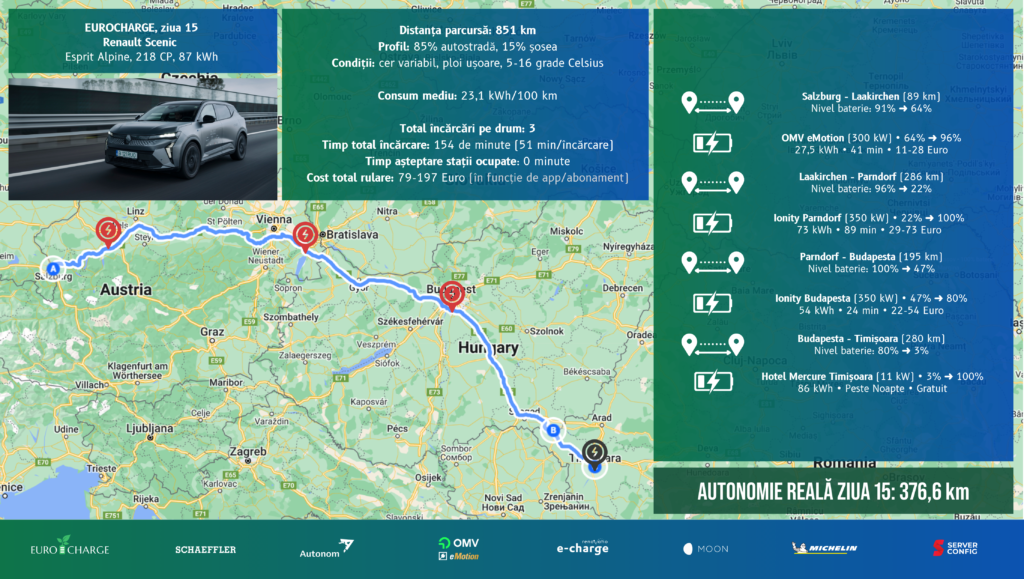
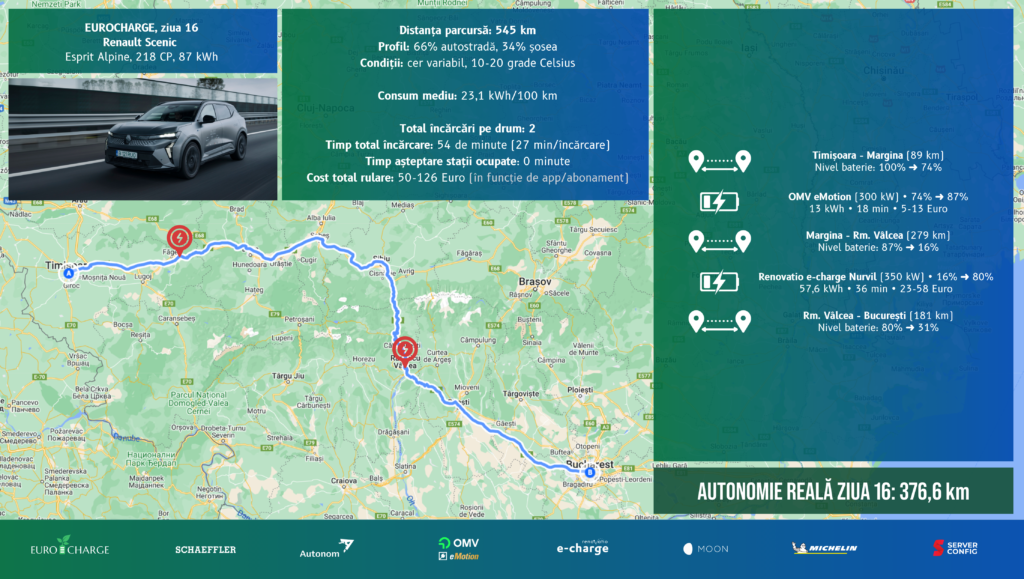
Alin Ionescu(The Machinist) about Volkswagen ID.7
Finally! A car born of our times that puts comfort before agile handling. The Volkswagen ID.7 is already nicknamed the Electric Passat. Although “modern-day Phaeton” would be more appropriate. Because there are luxury cars twice, even three times as expensive that don’t run as comfortably. Surprisingly, the ID.7 doesn’t even have air suspension, but a classic steel spring suspension. The secret lies in the optional adaptive dampers, which, in comfort mode, let the car puff like a Rolls. Maybe I’m exaggerating a bit, but in terms of road-holding, this VW isn’t far behind the world’s most expensive limos.
And it doesn’t drive badly, either. Yes, the body tilts, it feels heavy, but it’s balanced, predictable and the steering is very precise. The 282bhp electric motor driving the rear axle provides all the power you need at normal driving pace (overtaking and all), but with the 77kWh battery, the ID.7 is slightly short on range. Perhaps a larger 86 kWh battery configuration would be more appropriate, unleashing this Volkswagen’s full potential as a long-distance car.
Because otherwise, it has all the makings of a transcontinental automobile. Interior space is extremely generous, a consequence of the almost three-meter wheelbase. The soundproofing is excellent, the driving position is comfortable and the seats are divine. Because like the suspension, the ID.7’s seats (if you opt for the optional, ergoactive ones) are comparable to those in the most luxurious cars. In addition to carefully thought-out construction, shape and quality materials, they feature heating, ventilation and massage. The massage function is complex, working on both the backrest and the seat, with different modes that vary in amplitude, speed and firmness. ErgoActive seats are great in any situation, but especially on long journeys – especially for those with back problems. Over 800 km in a single day? They really don’t feel like it in the ID.7.
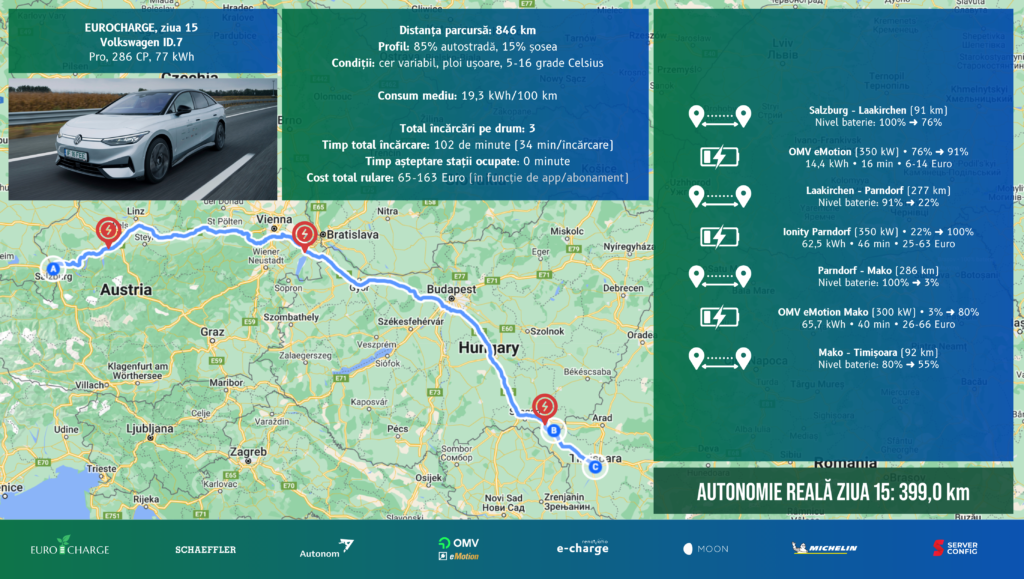
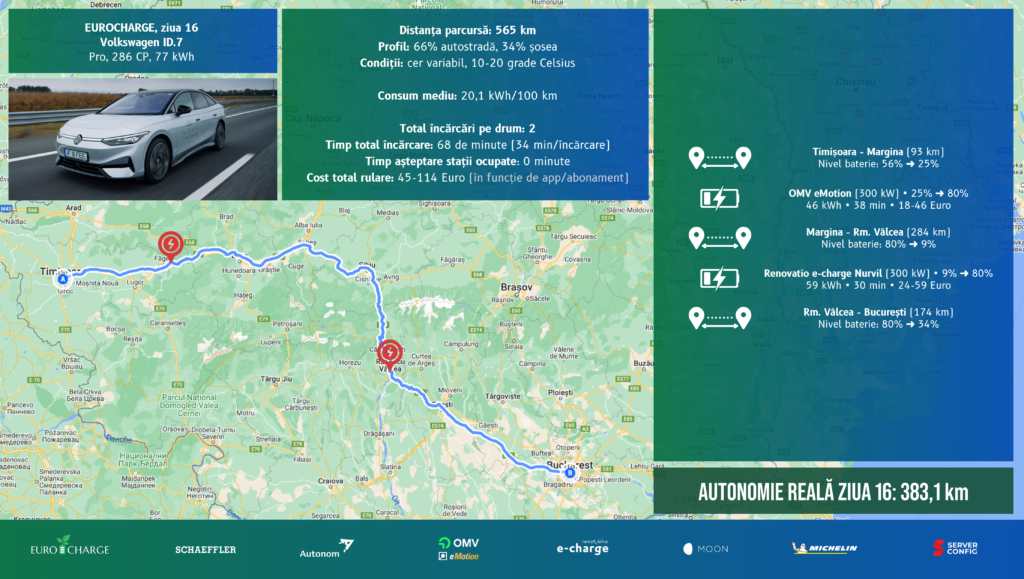
Berti Panaiot (AUTOCRITICA, urbanadventures.ro) on Volvo EX40
And we’re back in Bucharest. After 8661 kilometers covered in the Volvo EX40, it’s time for a short review. And, frankly, not even that immensely long hour spent senselessly in the Nădlac customs, waiting to enter Romania, managed to change my “zen” after this electric road trip.
I’ll start with what I liked. From a design point of view it may not be a car you’d turn your head to on the street, but I think that’s why I liked it. It’s something classic that I could see myself going out for a drive in every day.
I had plenty of room for luggage and everything else that had piled up on the road over the two weeks, and inside I didn’t get tangled up in any buttons or touch-screen controls.
I also liked the cornering and especially the long-distance handling, and the fact that I didn’t go straight for a massage after a day of over 1,000 kilometers says it all.
We’ve saved the most important things in an electric car for last. Even though it’s not equipped with state-of-the-art technology, the Volvo EX40 did well when it came to both charging time and range. And, yes, we found that 20 minutes wasn’t enough for a meal and that sometimes we stopped quicker for a quick bathroom break than the car had range. And no, we didn’t stop every 30 miles on the highway.
While I was initially thrilled with the Apple Car Play system, after the first few days of use I realized that it still didn’t work as well as I’d like. But know that the Android Automotive system saved the day in the end. Of course that doesn’t mean I’m giving up the iPhone.
What did I learn from the tour? First of all that you’re no longer eccentric or masochistic if you have an electric car. The infrastructure is constantly developing, and the fact that we had zero waiting times throughout the tour at stations says, I think, absolutely everything.
The best conclusion after this experience? Mircea Mester has already said it: “You don’t have to like electric cars and you don’t have to buy one. But if you’re thinking about it, here are all the figures to help you make the best decision.”
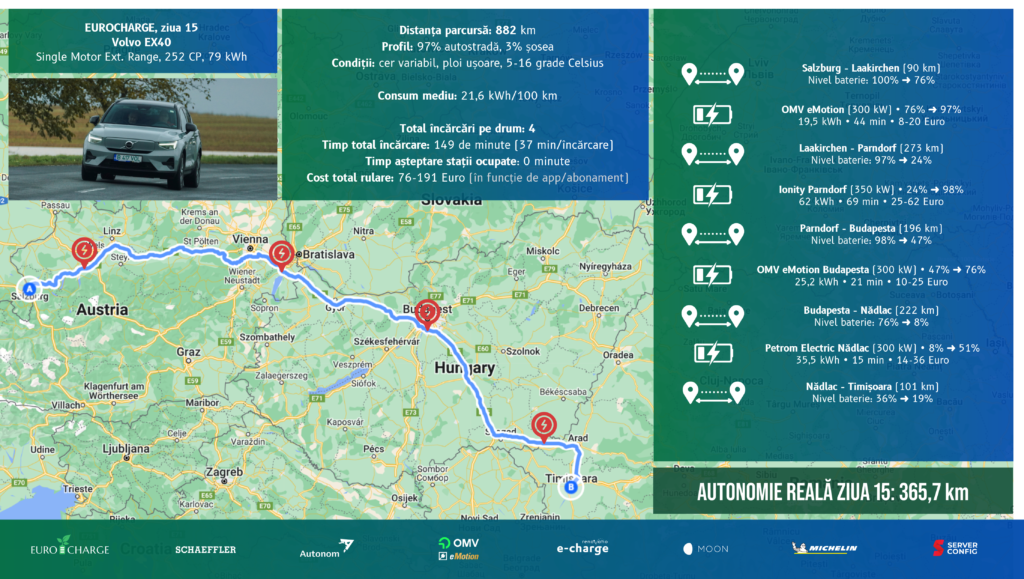
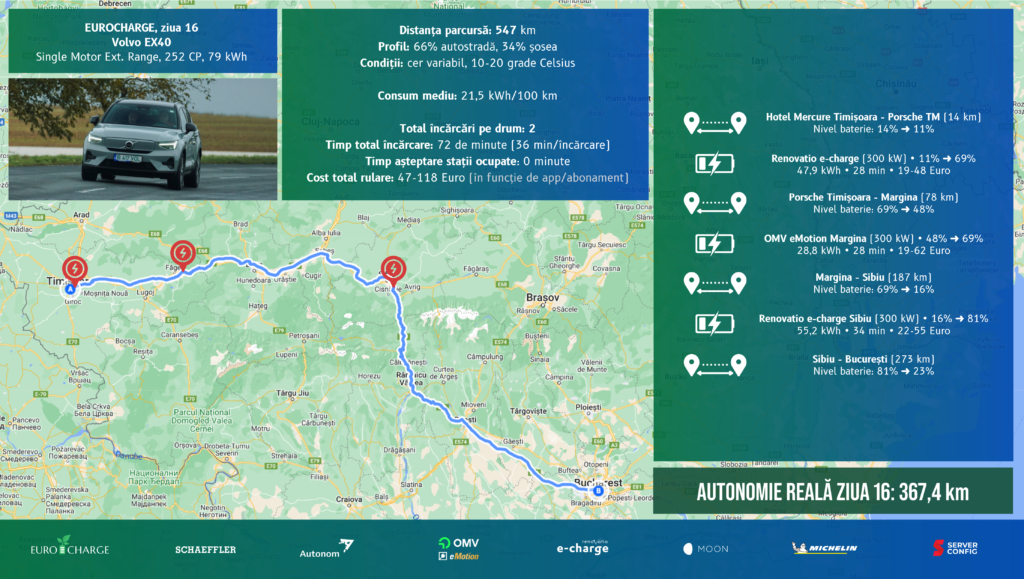
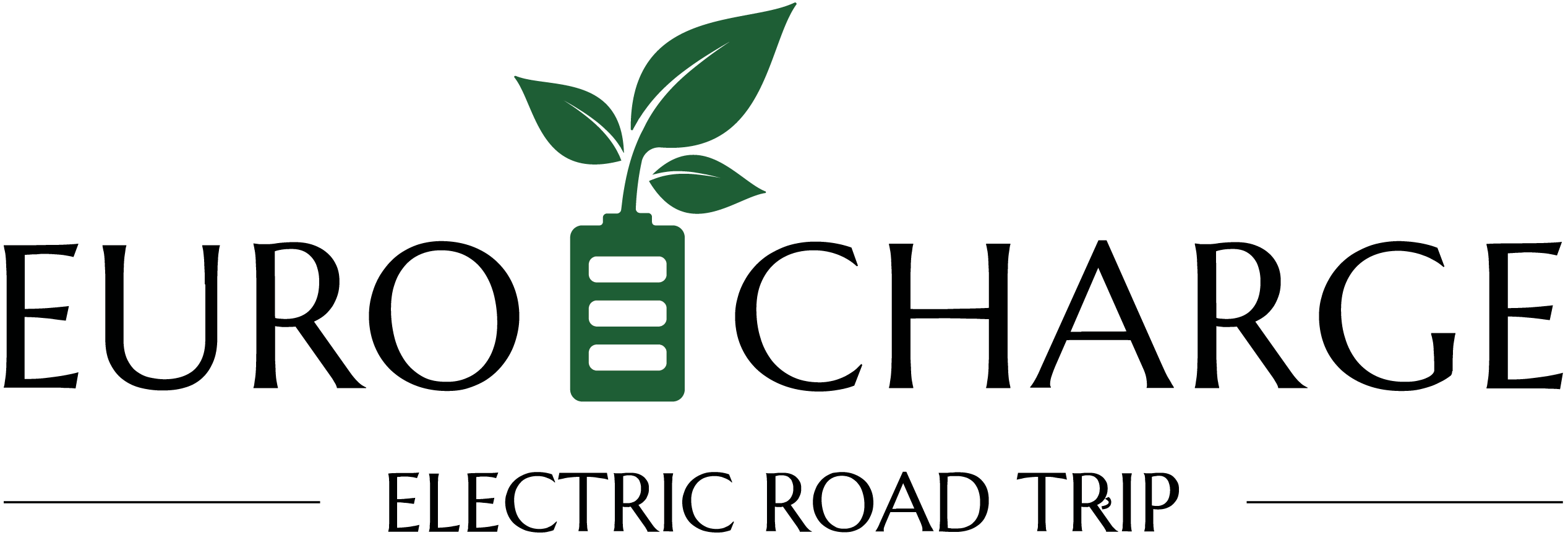
is a project backed by SCHAEFFLER
Charged by
OMV eMotion and Renovatio e-charge
Green Partner
Autonom
Charging stations
MOON România
On the road with
Michelin
Powered by
Server Config



